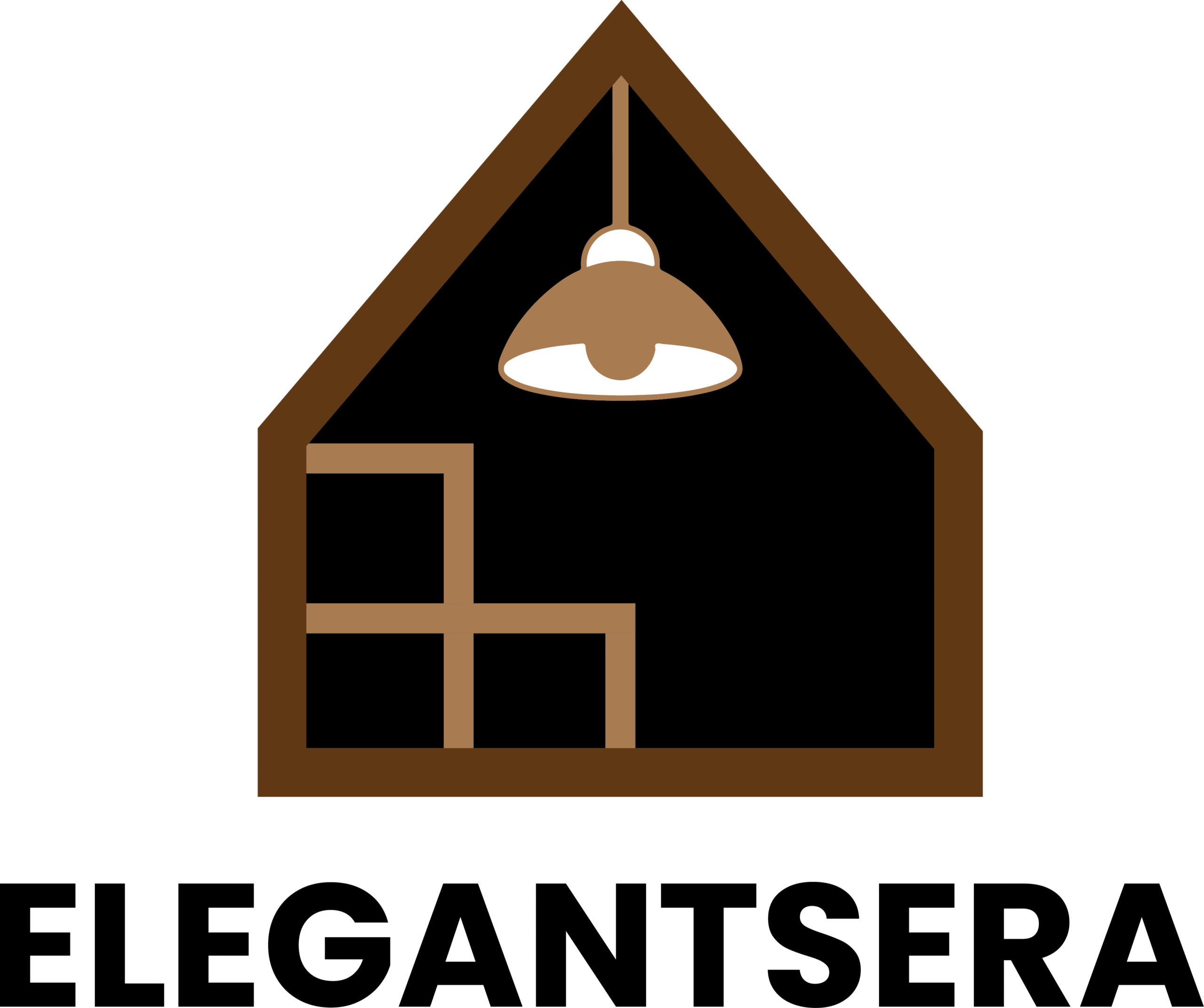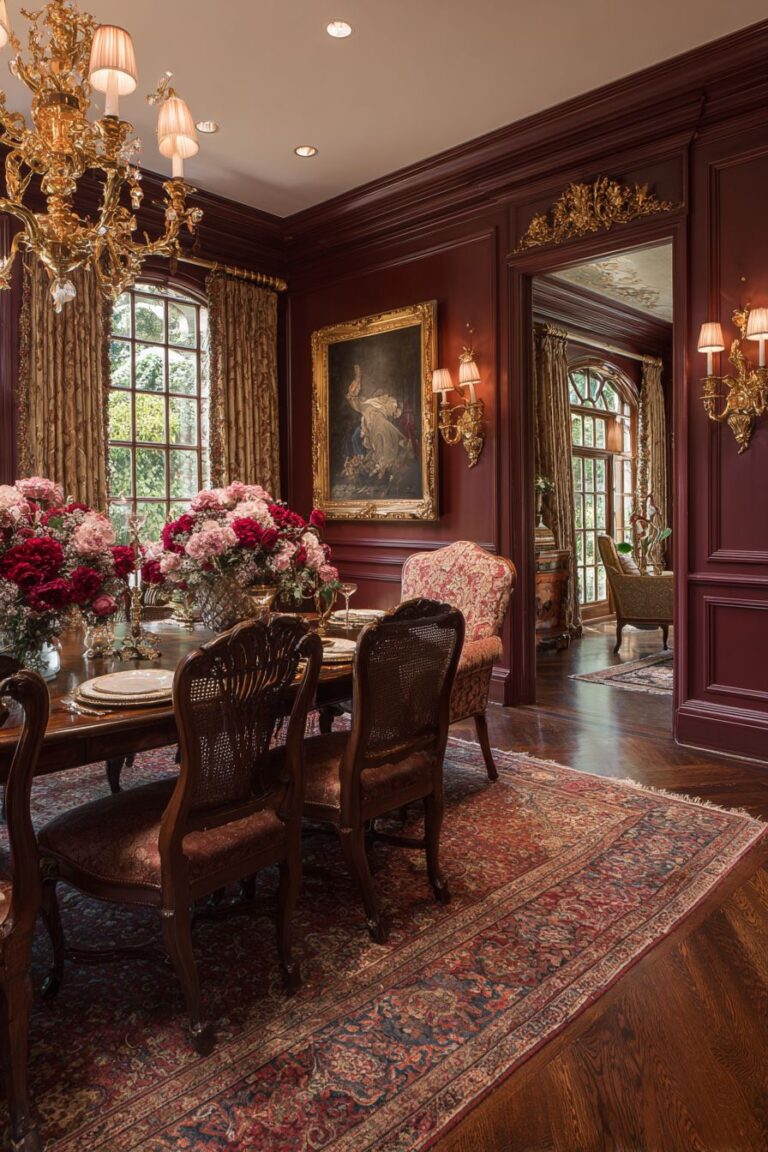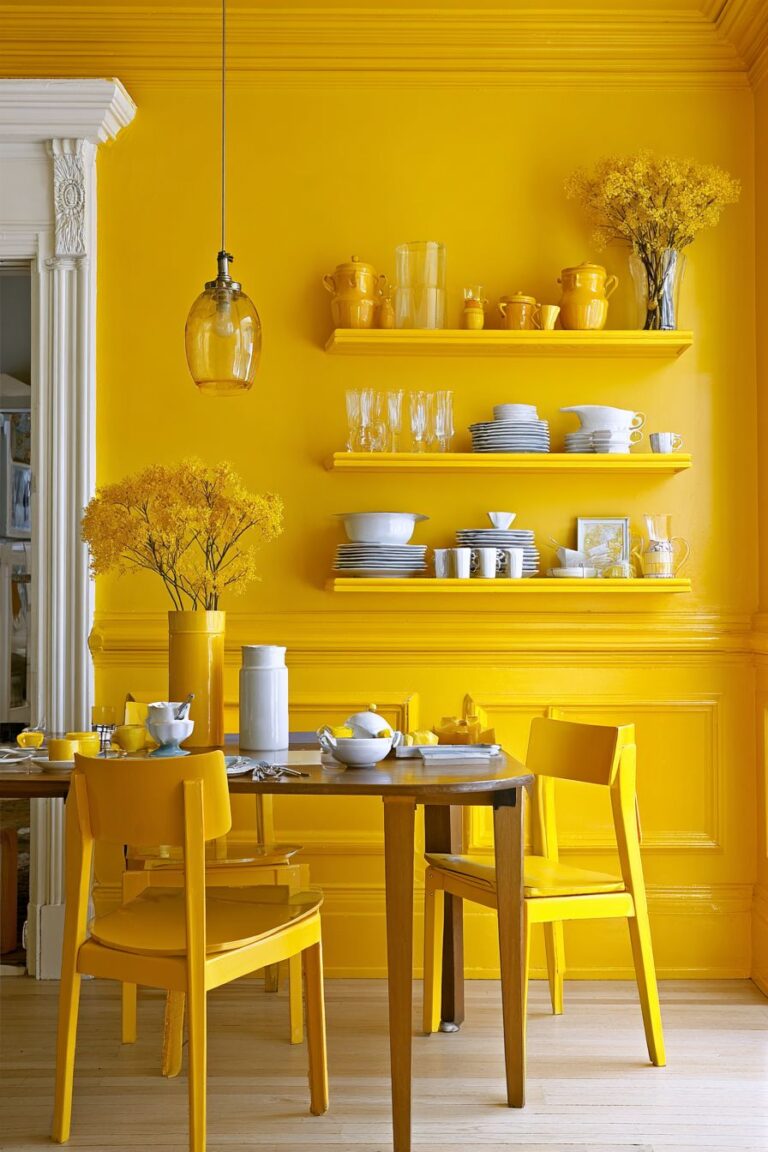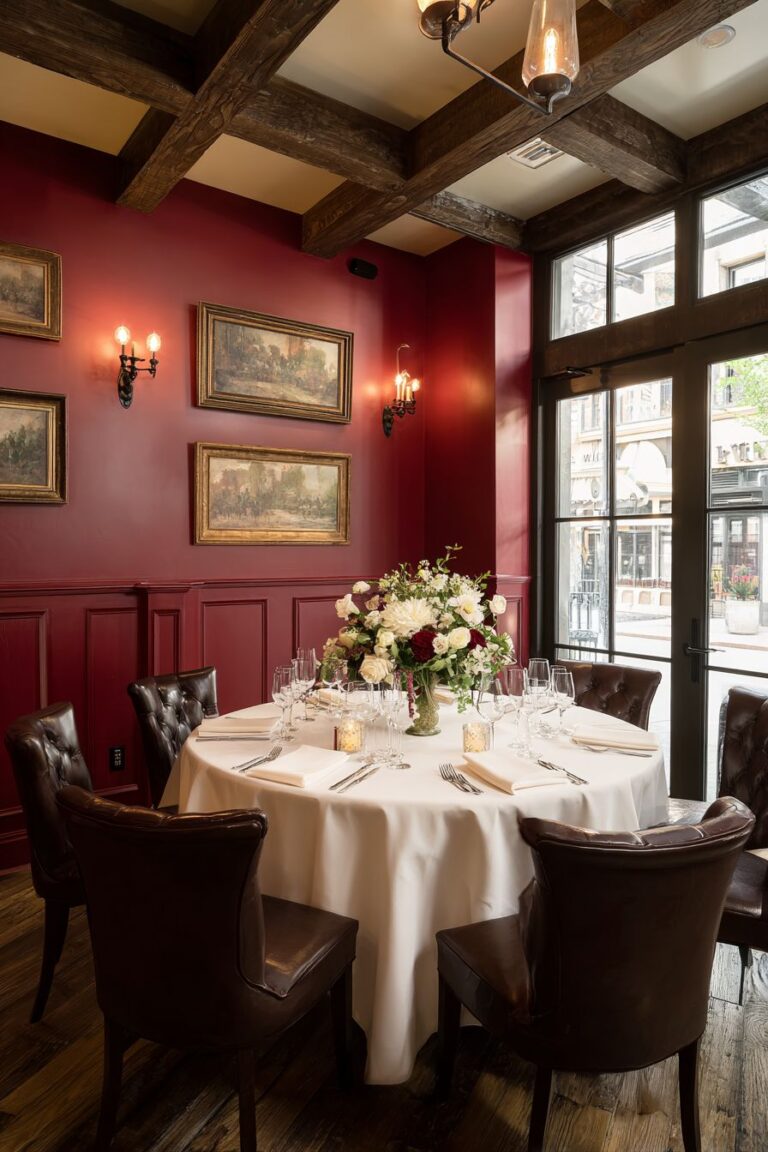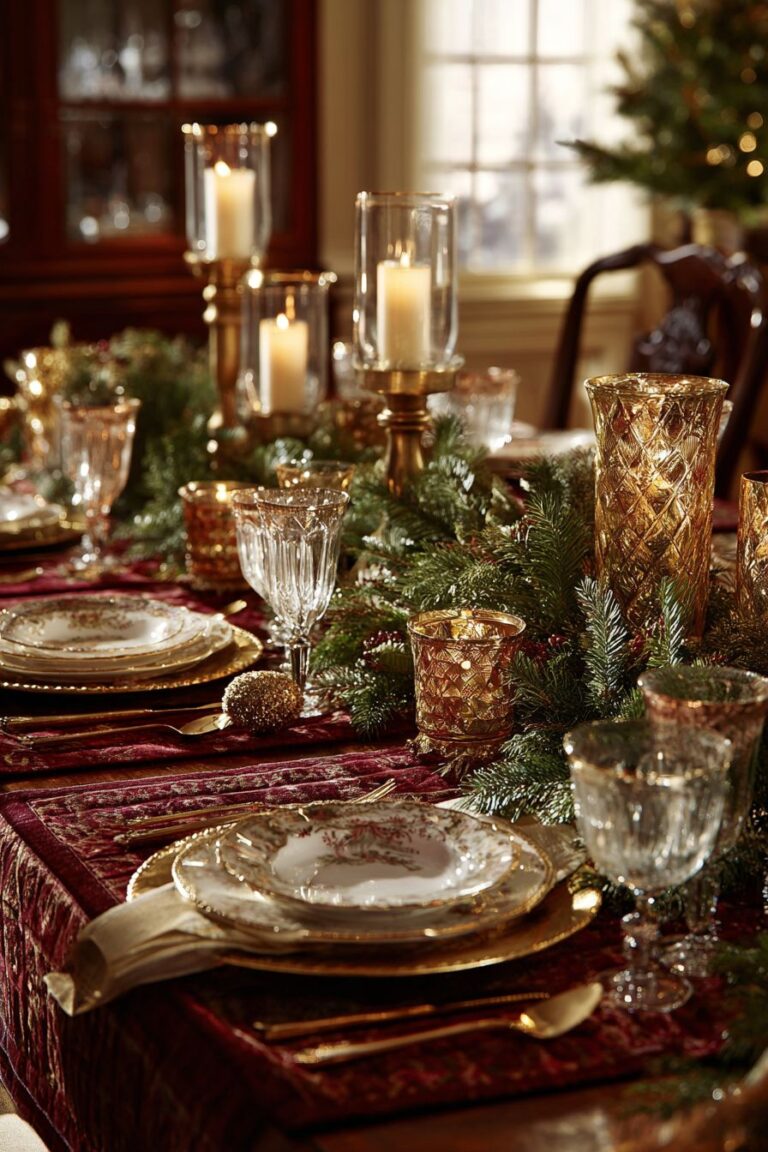20 Natural Dining Room Ideas: Design That Bring the Outdoors In
In today’s fast-paced world, there’s something deeply satisfying about creating spaces that ground us in nature’s timeless beauty. The dining room, as the heart of family gatherings and intimate conversations, deserves special attention when it comes to thoughtful interior design. A natural dining room doesn’t just serve meals—it nourishes the soul through carefully chosen materials, organic textures, and earthy color palettes that create an atmosphere of warmth and authenticity.
Natural design philosophy embraces the imperfections and character that come with organic materials, celebrating the unique grain patterns in wood, the subtle variations in stone, and the gentle wear that tells a story. This approach to interior design caters to those who value sustainability, craftsmanship, and the inherent beauty found in nature’s own creations. From live-edge dining tables that showcase a tree’s natural form to woven textures that add tactile richness, natural dining rooms create spaces where people instinctively want to linger and connect.
The following collection of natural dining room concepts demonstrates the incredible versatility of organic design principles. Each space tells a unique story through carefully curated materials, thoughtful lighting solutions, and furnishings that honor both function and beauty. Whether you’re drawn to rustic farmhouse charm, modern organic minimalism, or eclectic vintage appeal, these natural dining room designs offer inspiration for creating spaces that feel both sophisticated and grounded in the earth’s natural beauty.
1. Live-Edge Walnut Centerpiece with Rattan Accents

The magnificent live-edge walnut dining table commands attention as the undisputed centerpiece of this natural dining room. Its raw, unfinished edges tell the story of the tree it once was, while the rich chocolate and honey tones of the wood grain create mesmerizing patterns that seem to flow like rivers across the surface. Natural knots and mineral streaks add character and authenticity, making each viewing angle reveal new details and imperfections that celebrate nature’s artistic hand.
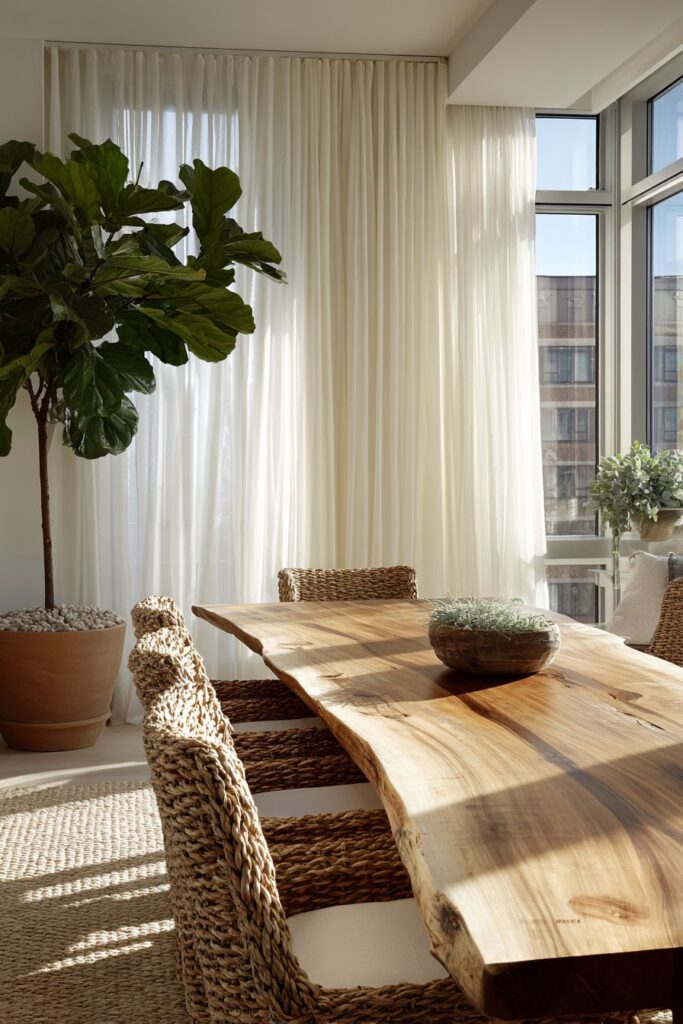
Surrounding this stunning table, woven rattan chairs with plush linen cushions in cream tones provide both comfort and visual softness. The organic curves of the rattan create a beautiful contrast against the table’s straight edges, while the natural fiber construction adds textural depth and warmth. The cream-colored cushions introduce a light, airy element that prevents the space from feeling too dark or heavy despite the rich wood tones.
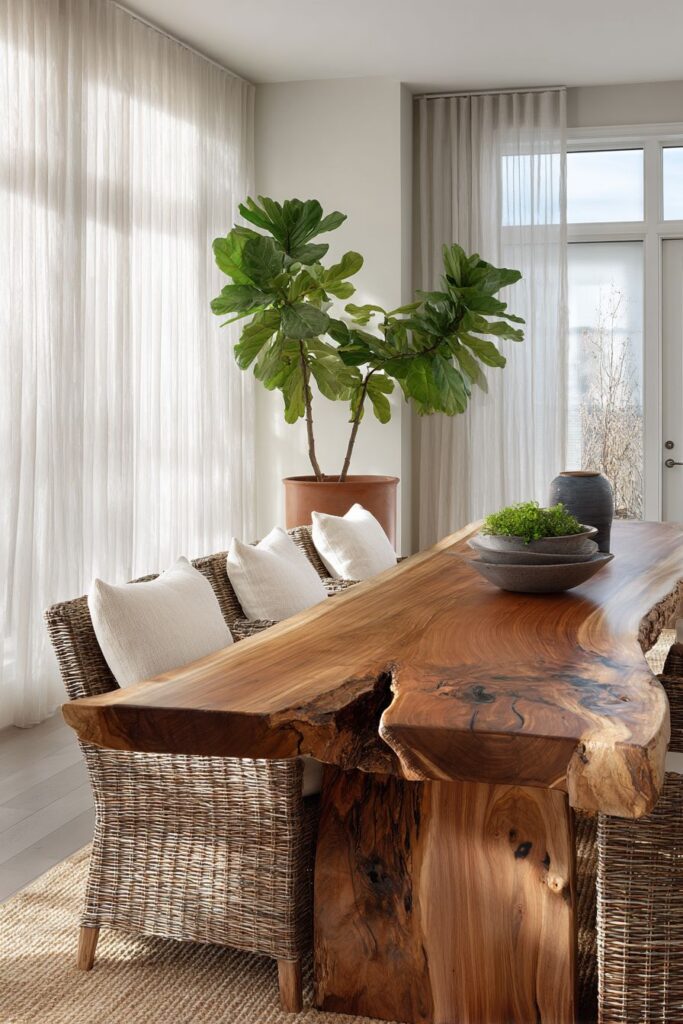
A jute area rug anchors the entire seating arrangement, its natural fibers and neutral coloring providing a foundation that allows the walnut table to shine. The rug’s subtle texture adds another layer of organic interest while defining the dining zone within the larger room. Strategically placed fiddle leaf fig plants in terracotta pots bring living greenery into the space, their broad leaves creating dramatic silhouettes and adding vertical elements that draw the eye upward.
The magic of this design truly comes alive when soft natural light streams through sheer linen curtains, casting gentle shadows that highlight every detail of the wood’s natural texture. These shadows dance across the surface throughout the day, creating an ever-changing display of light and shadow that keeps the space feeling dynamic and alive.
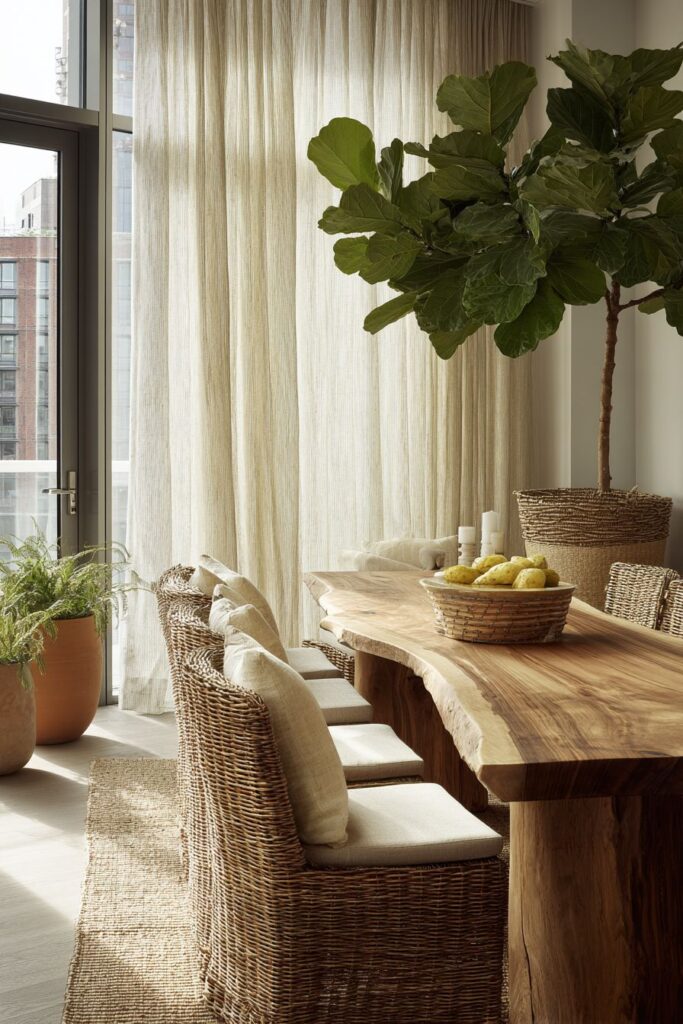
Key Design Tips:
- Choose live-edge furniture to showcase wood’s natural beauty and character
- Mix different natural textures like rattan, jute, and linen for visual interest
- Use plants as living sculpture to add organic vertical elements
- Install sheer curtains to filter harsh light while maintaining connection to outdoors
- Select neutral cushion colors to balance darker wood tones
2. Reclaimed Wood Storage with Clay Plaster Accent Wall
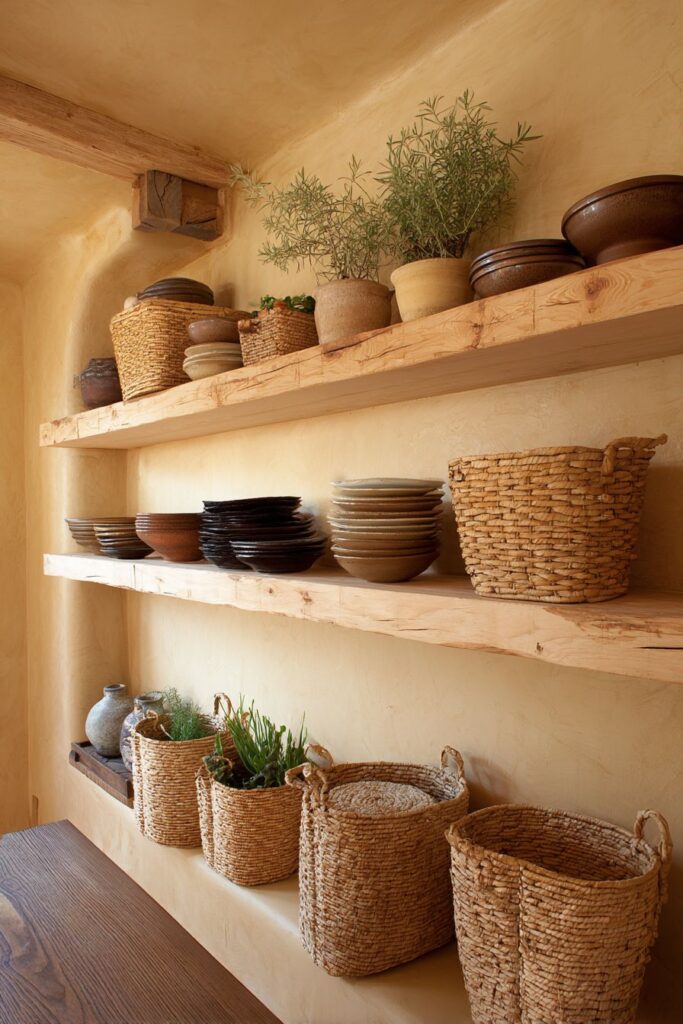
This natural dining room demonstrates how storage can become a stunning design feature rather than a functional afterthought. Built-in floating shelves crafted from reclaimed barn wood span an entire accent wall, their weathered surfaces telling stories of their previous life while providing practical storage for ceramic dishes and woven baskets. Each plank shows unique wear patterns, nail holes, and color variations that create visual interest and authenticity that can’t be replicated with new materials.
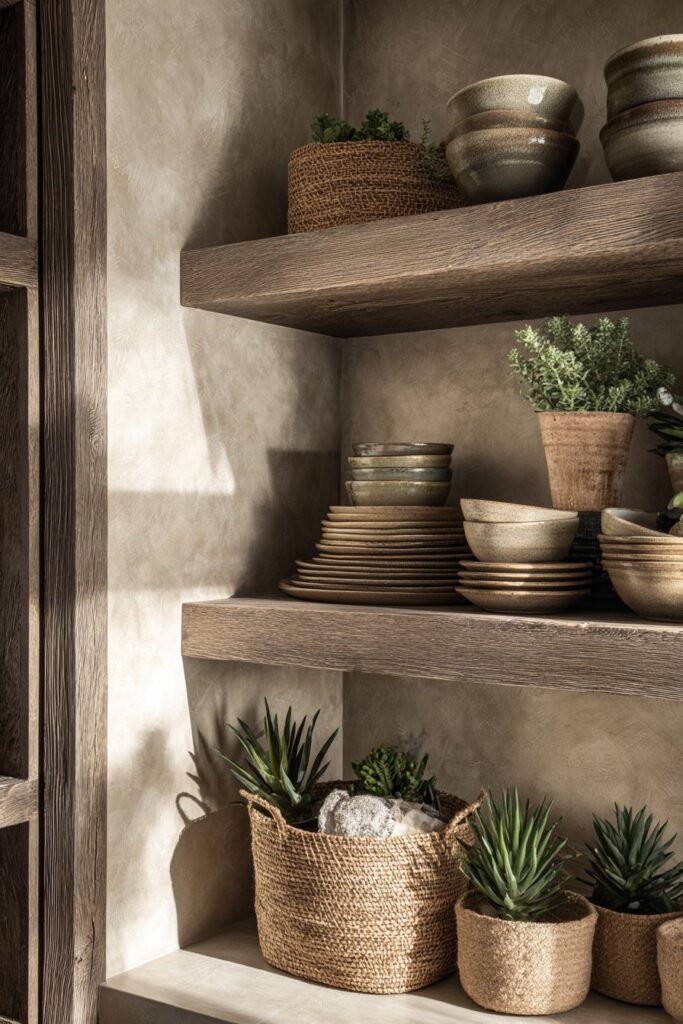
The backdrop for these shelves features a natural clay plaster finish in warm beige tones, creating a sophisticated textural surface that complements the rustic wood perfectly. The organic nature of clay plaster means slight variations in color and texture across the wall, adding depth and visual interest while maintaining the natural aesthetic. This earth-based material creates a sense of groundedness and connection to natural building traditions.
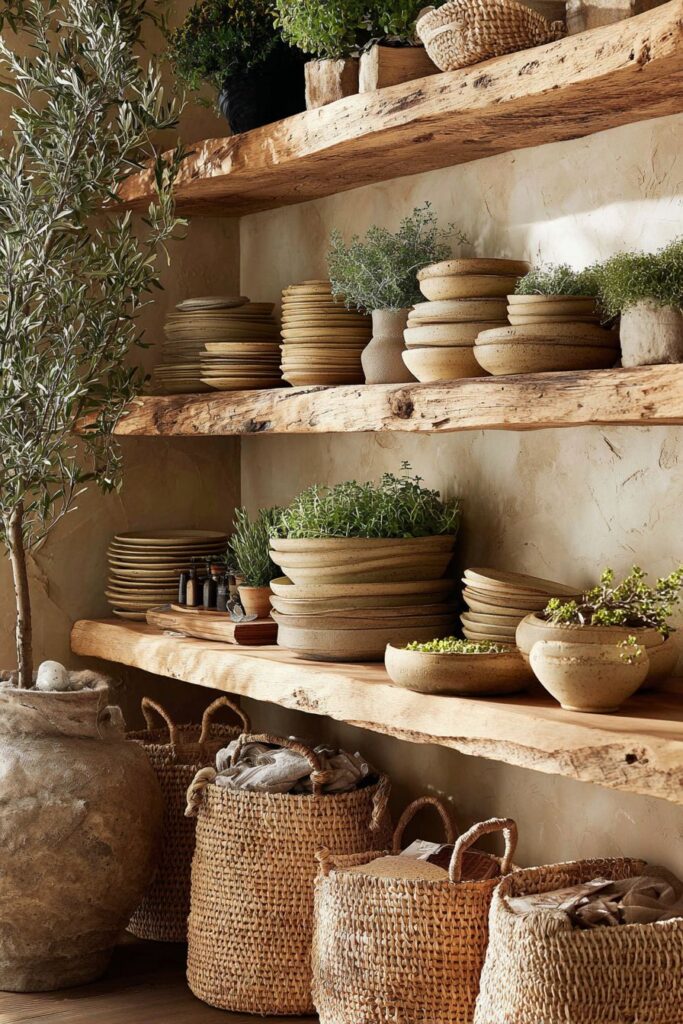
The display items themselves become part of the design story, with ceramic dishes in earth tones ranging from warm terracotta to sage green creating a curated collection that feels both functional and artistic. Woven baskets in various sizes provide hidden storage while adding another layer of natural texture. Small potted herbs and succulents interspersed among the dishware bring life and freshness to the display, creating a living gallery that changes with the seasons.
The balanced natural lighting in this space is crucial to showcasing the organic textures and functional beauty of these natural materials. Carefully positioned light sources highlight the grain in the reclaimed wood, create subtle shadows that emphasize the clay plaster’s texture, and make the ceramic glazes appear to glow with inner warmth.
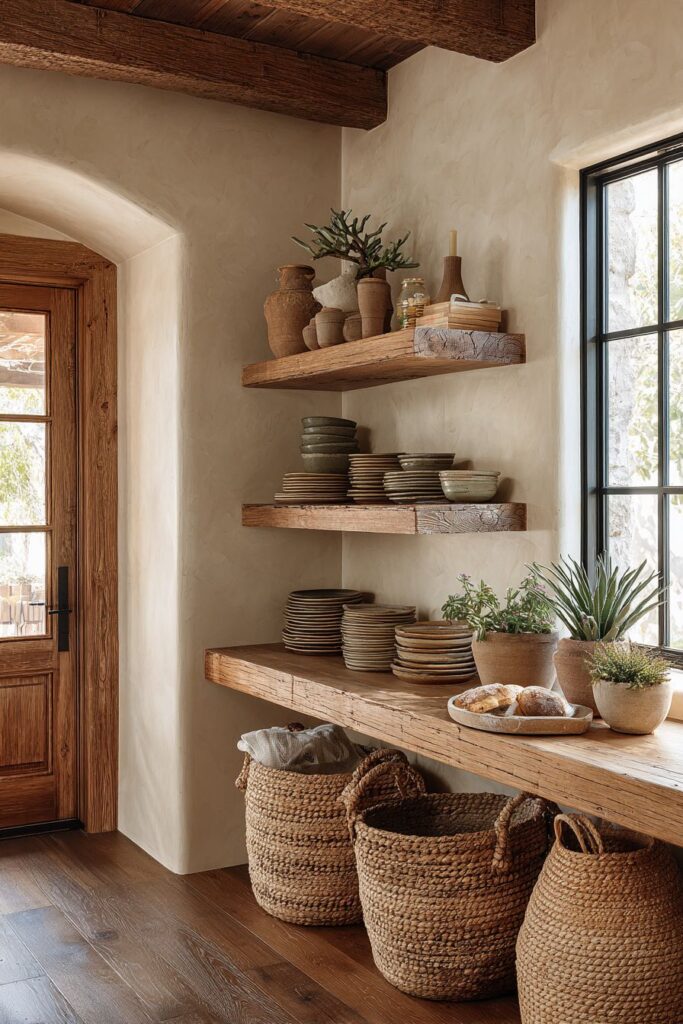
Key Design Tips:
- Use reclaimed materials to add instant character and sustainability
- Create floating shelves that span entire walls for maximum visual impact
- Mix functional items with decorative objects for curated displays
- Choose clay plaster finishes for authentic texture and warmth
- Incorporate living plants among stored items for freshness and vitality
3. Rustic Oak Farmhouse Table with Vintage Chair Mix
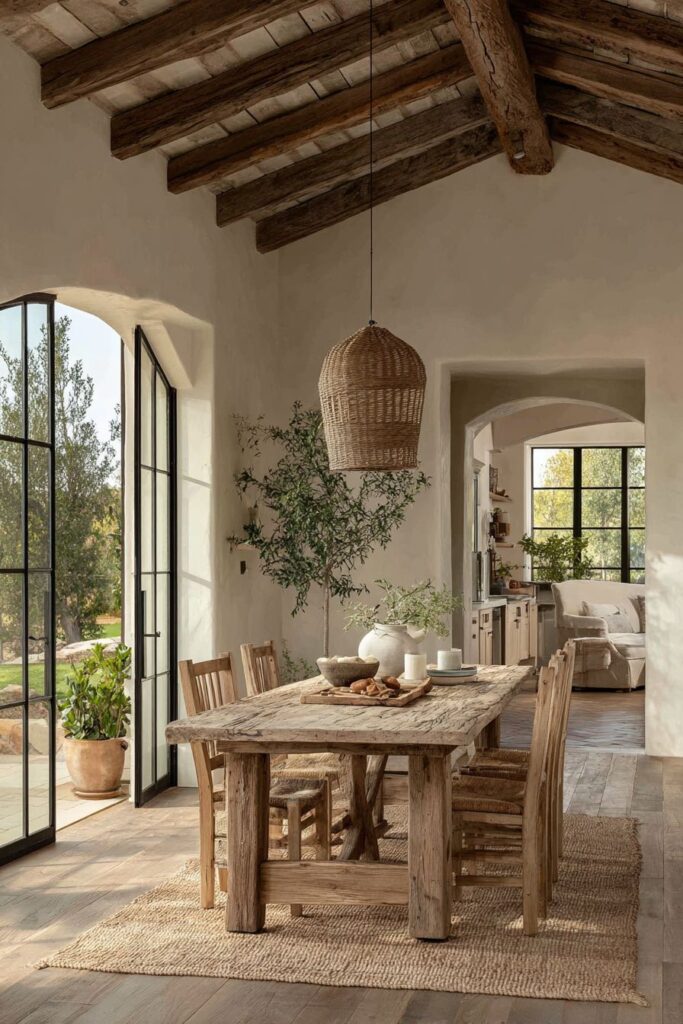
The centerpiece of this charming natural dining room is a substantial oak farmhouse table that bears the honest marks of traditional craftsmanship. Visible saw marks across the surface create subtle texture that catches light beautifully, while the natural wood patina tells the story of countless family meals and gatherings. The table’s generous proportions and sturdy construction speak to a time when furniture was built to last generations, embodying values of sustainability and quality that resonate strongly in today’s design landscape.
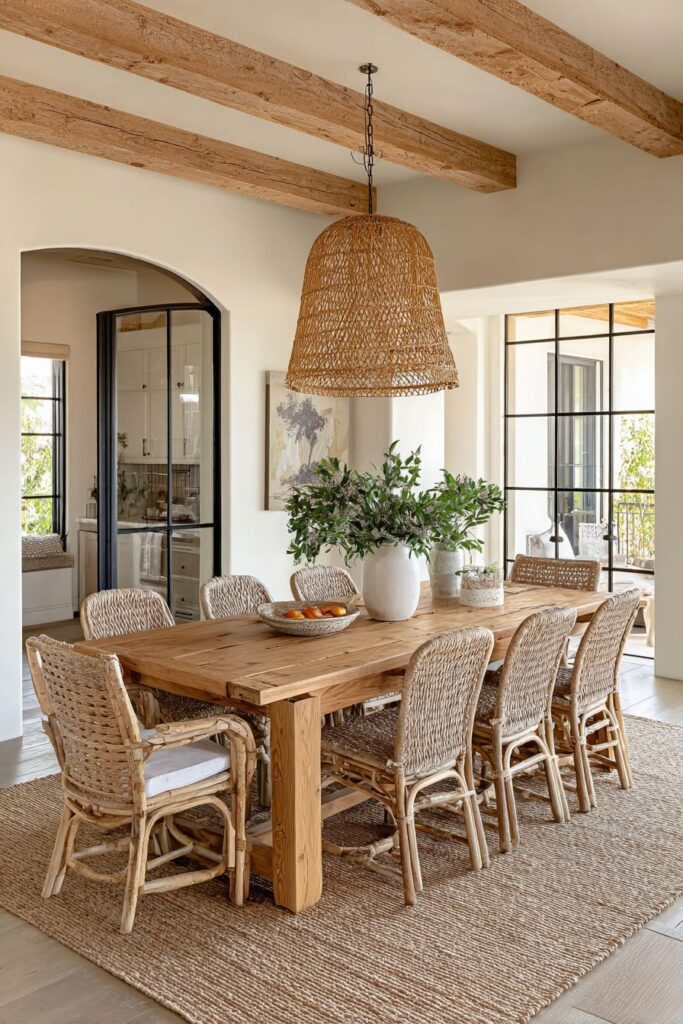
Perhaps the most delightful aspect of this design is the collection of mismatched vintage wooden chairs surrounding the table. Each chair represents a different era and style, from Windsor backs to ladder backs, creating an eclectic gathering that feels like it evolved naturally over time. The unique wear patterns on each chair add to their individual character, showing smooth spots where hands have rested and gentle scuffs that speak to decades of use and care.
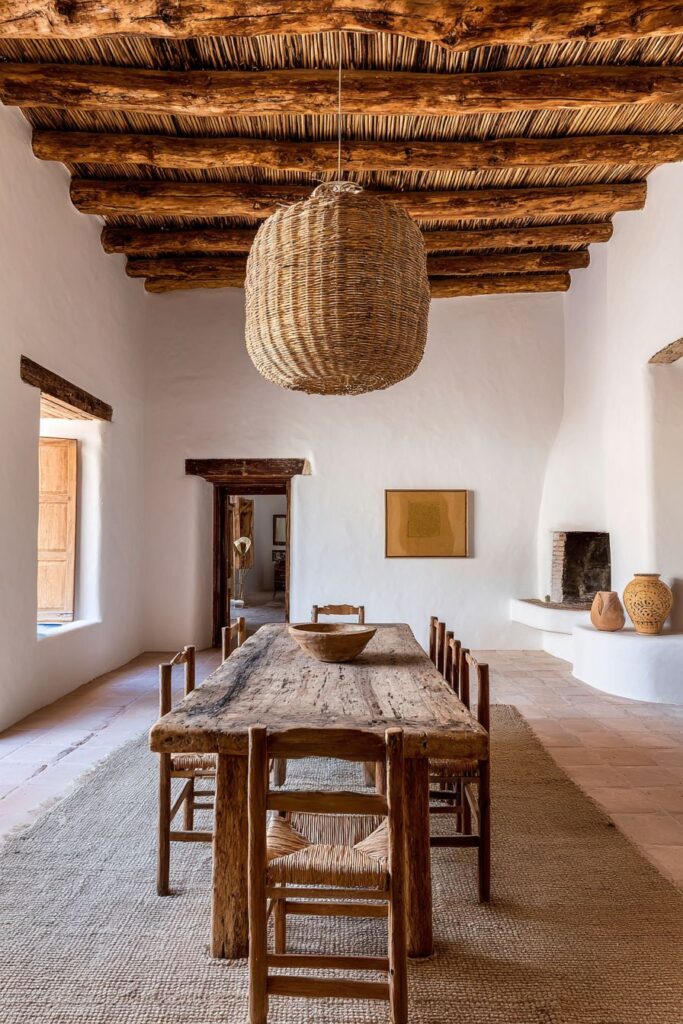
Suspended above this gathering place, a woven pendant light fixture made from natural rattan provides both illumination and artistic interest. The organic form of the pendant contrasts beautifully with the angular lines of the table and chairs while maintaining the natural material palette. Its warm ambient light creates an intimate atmosphere perfect for long dinners and meaningful conversations.
The space is further enhanced by exposed wooden ceiling beams that add architectural interest and reinforce the rustic aesthetic. A sisal area rug grounds the seating area with its natural fiber texture and neutral coloring, allowing the beautiful wood tones of the furniture to remain the focus while providing comfort underfoot.
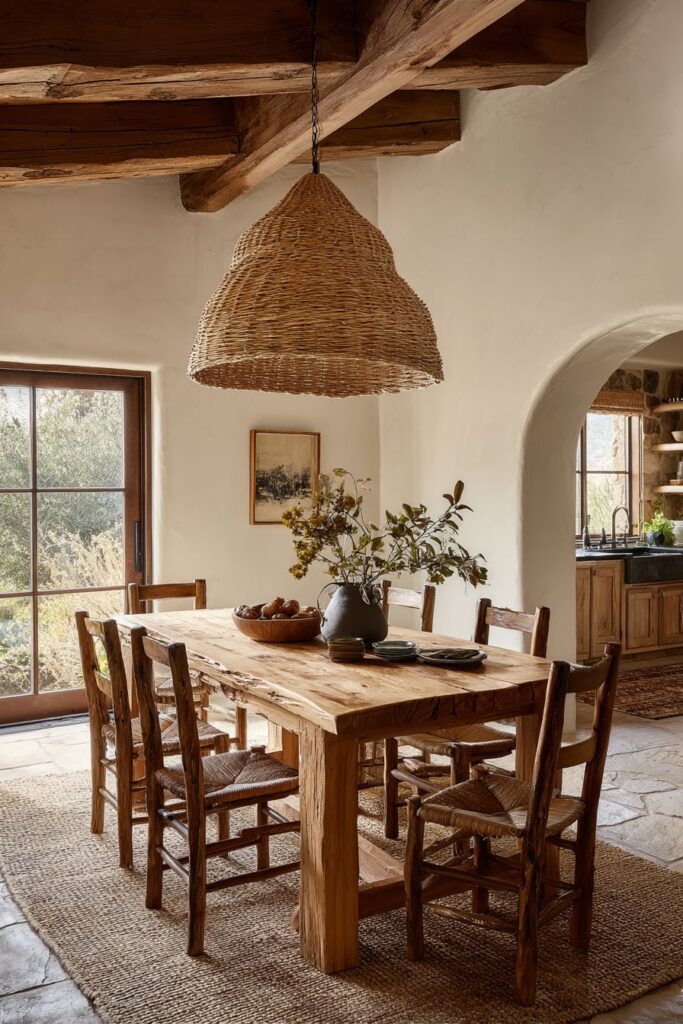
Key Design Tips:
- Embrace mismatched vintage chairs for authentic eclectic charm
- Look for furniture with visible craftsmanship marks and patina
- Use natural fiber rugs to ground seating areas without competing visually
- Install pendant lighting that complements rather than competes with furniture
- Expose architectural elements like beams to enhance rustic character
4. Sage Green Banquette with Bamboo Roman Shades
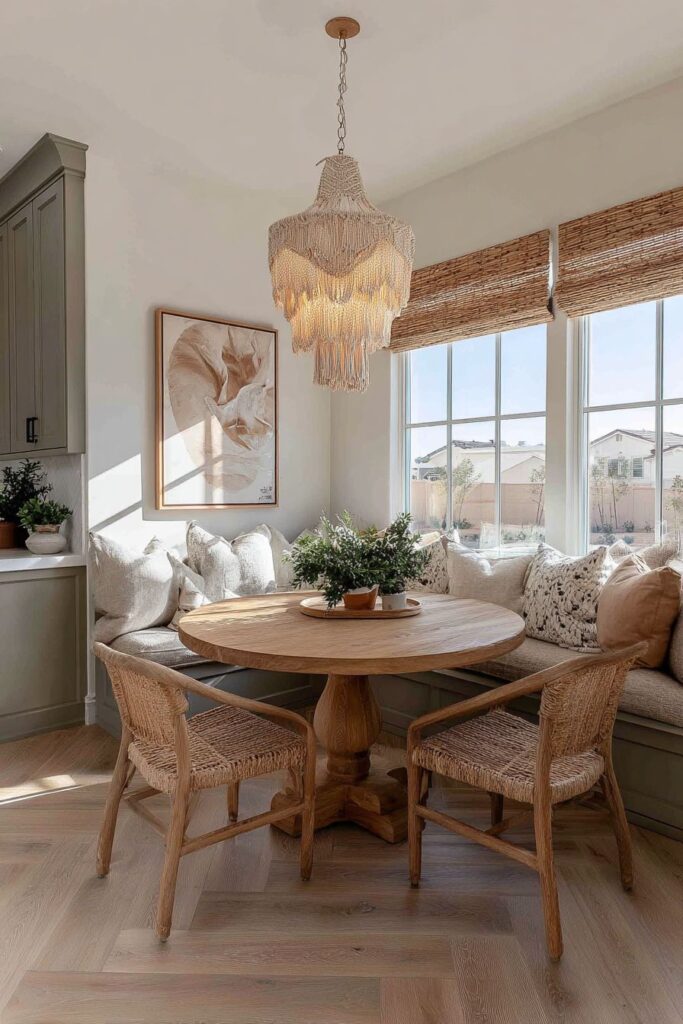
This inviting natural dining room breakfast nook creates an intimate retreat perfect for morning coffee and casual meals. The built-in banquette features organic linen upholstery in a sophisticated sage green that connects the interior space with nature’s palette while providing comfortable seating that maximizes the available space. The soft, matte finish of the linen fabric adds textural interest and creates a sense of relaxed elegance that feels both refined and approachable.
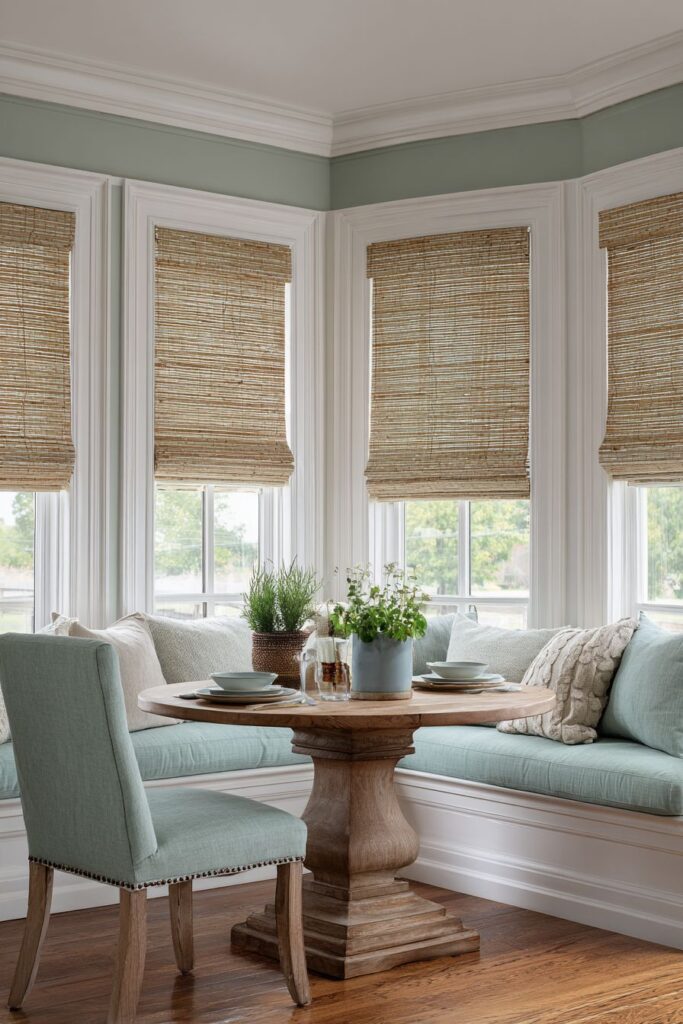
Positioned strategically beneath windows, the banquette takes advantage of natural light while the bamboo Roman shades provide flexible light control throughout the day. The natural bamboo material maintains the organic aesthetic while offering practical benefits like UV protection and privacy. The linear pattern of the bamboo adds subtle geometric interest that contrasts beautifully with the soft curves of the upholstered seating.
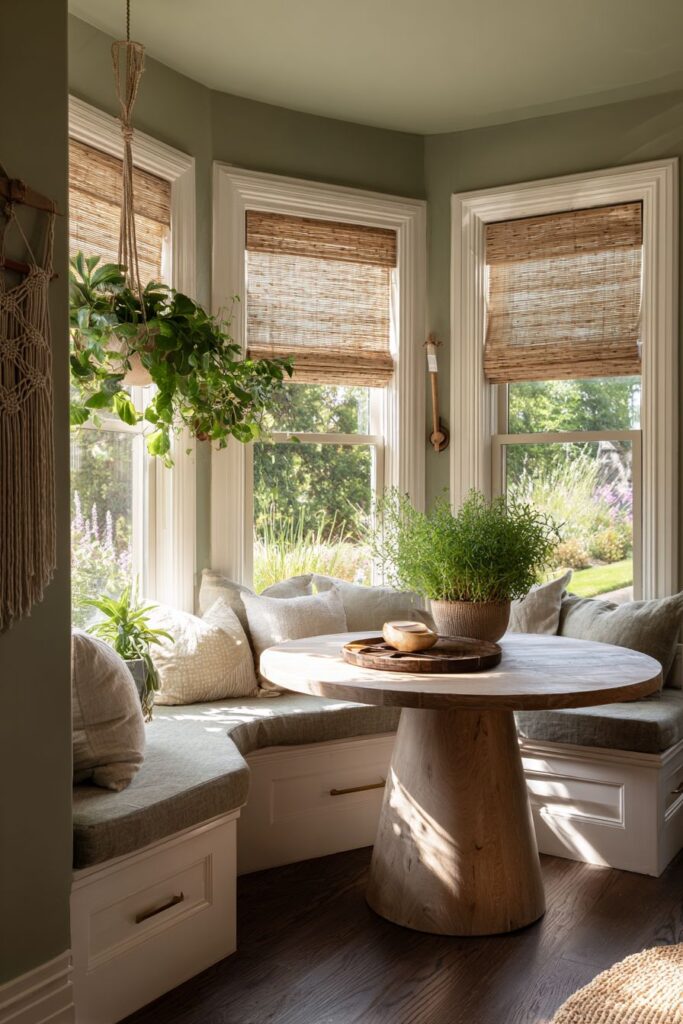
The round pedestal table made from solid oak with a natural oil finish serves as the perfect centerpiece for this intimate dining nook. Its circular shape encourages conversation and creates better traffic flow in the compact space, while the natural oil finish allows the wood’s grain and character to show through while providing protection. The pedestal base maximizes legroom and creates a cleaner visual line than traditional four-leg tables.
A charming herb garden lines the windowsill, bringing fresh scents and living greenery directly into the dining space. These practical plants serve double duty as both decoration and ingredients for meals, reinforcing the connection between the dining room and nature’s bounty. A macrame wall hanging adds additional textural interest and artisanal character that complements the handcrafted feel of the space.
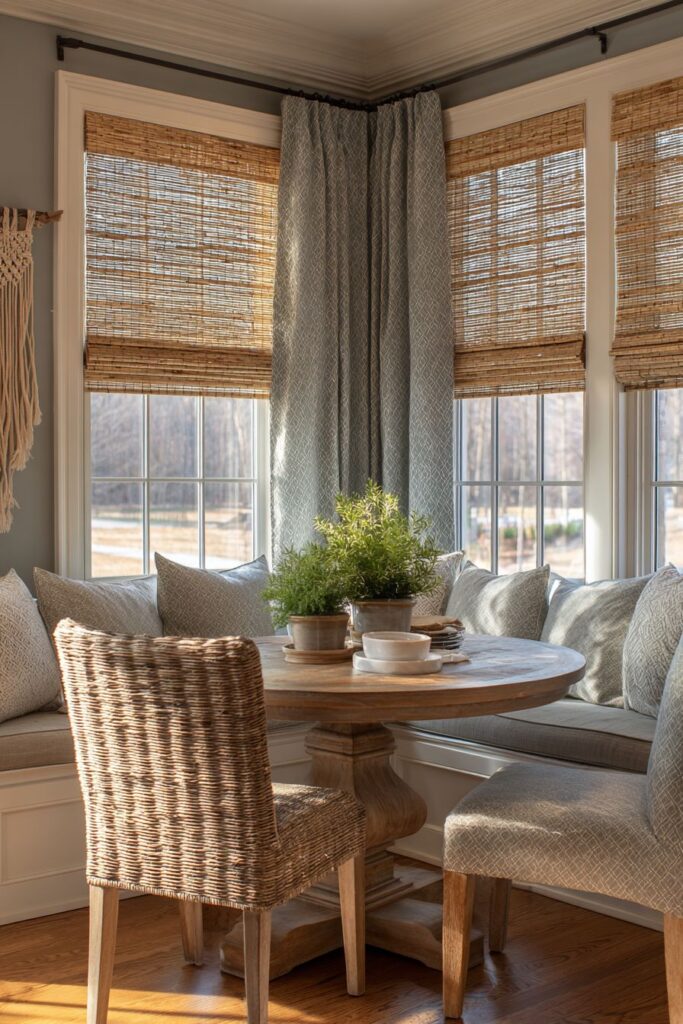
Key Design Tips:
- Choose built-in seating to maximize space efficiency in small dining areas
- Select organic fabric colors that connect interior spaces with nature
- Use natural window treatments for light control without sacrificing style
- Create herb gardens on windowsills for fresh ingredients and living decor
- Add handcrafted elements like macrame for artisanal character
5. Woven Pendant Light Collection Above Teak Table

This striking natural dining room showcases the dramatic impact that thoughtful lighting design can have on a space. A carefully curated collection of woven pendant lights in varying sizes creates a sculptural installation above the rectangular teak dining table. Made from natural materials like bamboo and rattan, these fixtures demonstrate how functional lighting can become artistic expression while maintaining the organic aesthetic throughout the space.
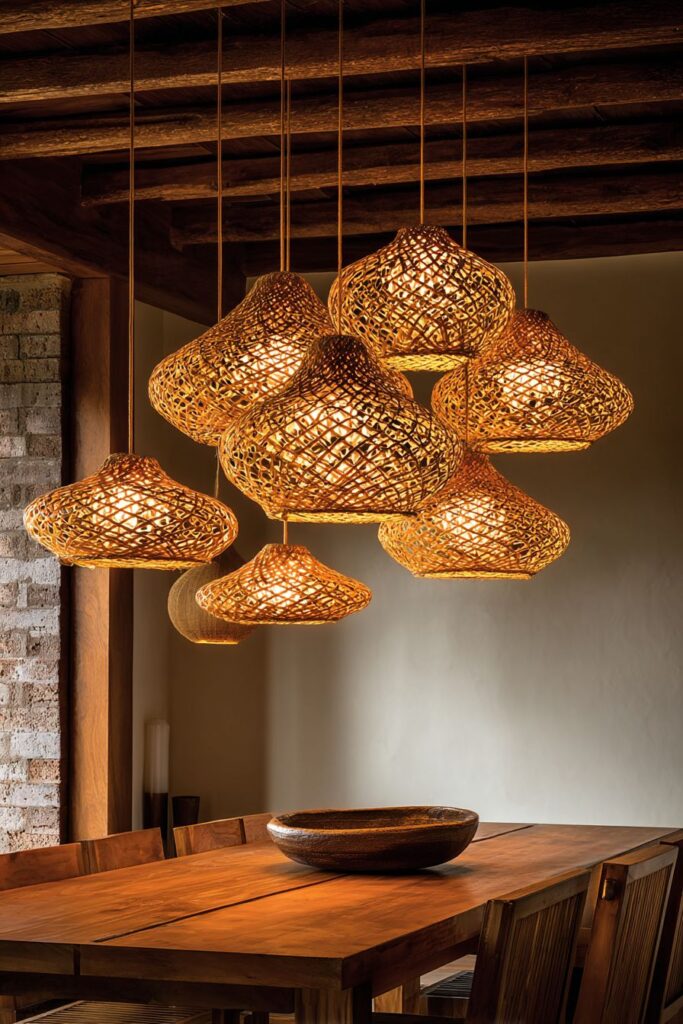
The genius of this design lies in the varied heights at which the pendants are suspended, creating visual rhythm and preventing the lighting from feeling too uniform or predictable. The different sizes and materials of each fixture add to the organic, collected-over-time feeling that makes natural interiors so appealing. The interplay between the various textures and weaves creates complex shadow patterns that change throughout the day as natural light shifts.
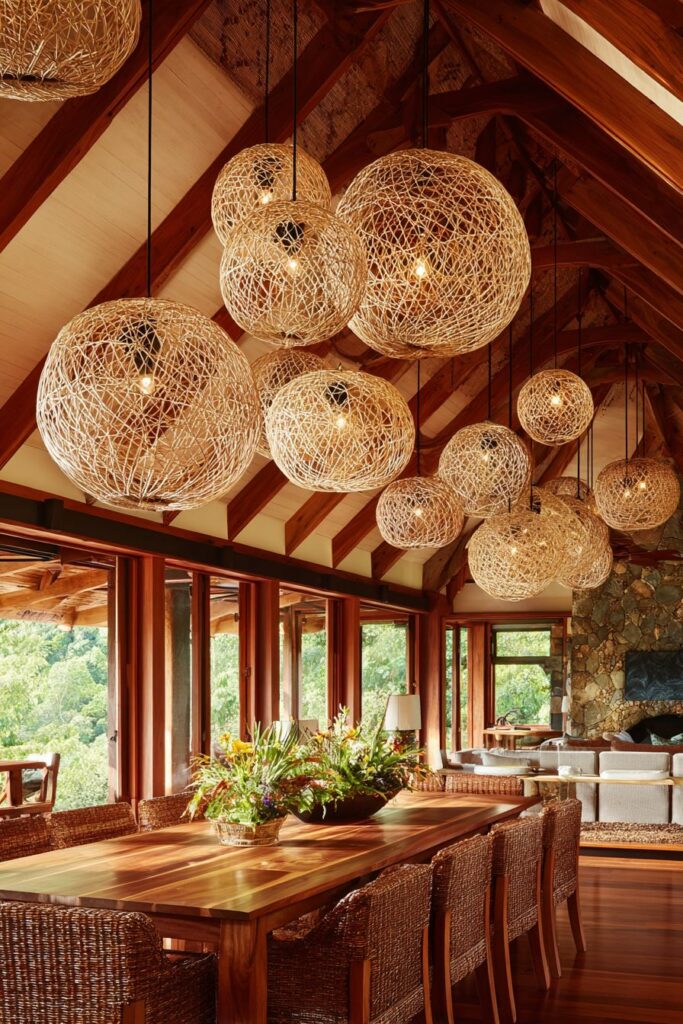
The rectangular teak dining table beneath this lighting installation provides a gorgeous foundation with its rich, warm wood tones and distinctive grain patterns. Teak’s natural oils give it a lustrous finish that seems to glow from within, while its durability makes it perfect for family dining. The table’s clean lines provide a sophisticated contrast to the organic curves and textures of the pendant lights above.
Exposed wooden ceiling beams with a natural finish add architectural interest and provide the necessary structure for hanging the varied pendant lights at different heights. These beams also reinforce the natural material palette and create visual connection between the lighting installation and the overall room design.
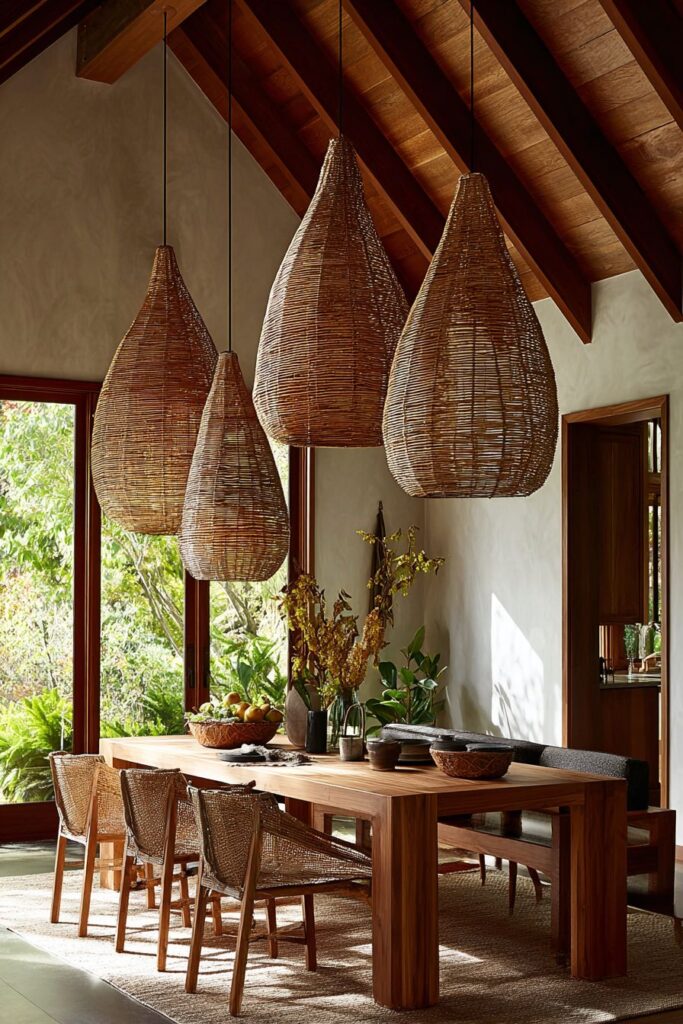
Key Design Tips:
- Group pendant lights in odd numbers for pleasing visual composition
- Vary heights and sizes to create dynamic lighting installations
- Choose natural materials for fixtures to maintain organic aesthetic
- Use quality hardwoods like teak for long-lasting beauty and functionality
- Expose ceiling beams to add architectural character and hanging points
6. Fieldstone Accent Wall with Chestnut Table
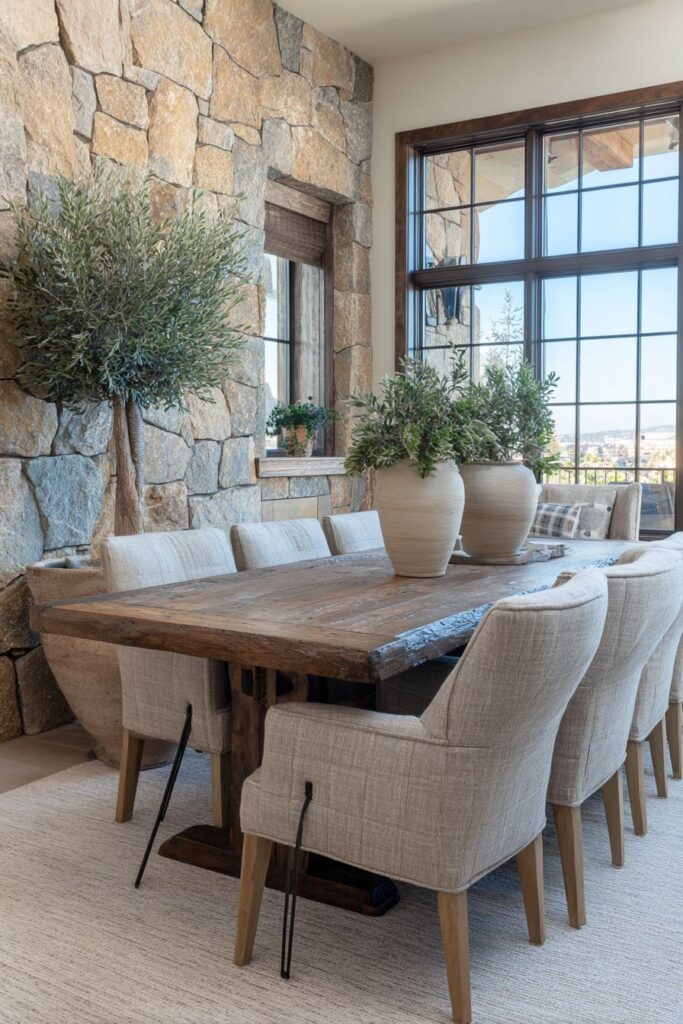
This sophisticated natural dining room demonstrates how to successfully combine different organic materials for maximum visual impact. The stunning stone accent wall features carefully stacked fieldstone in natural grey and beige tones, creating a dramatic backdrop that brings the rugged beauty of nature’s geology indoors. Each stone is unique in size, shape, and coloring, creating a complex tapestry that serves as living artwork and adds substantial textural interest to the space.
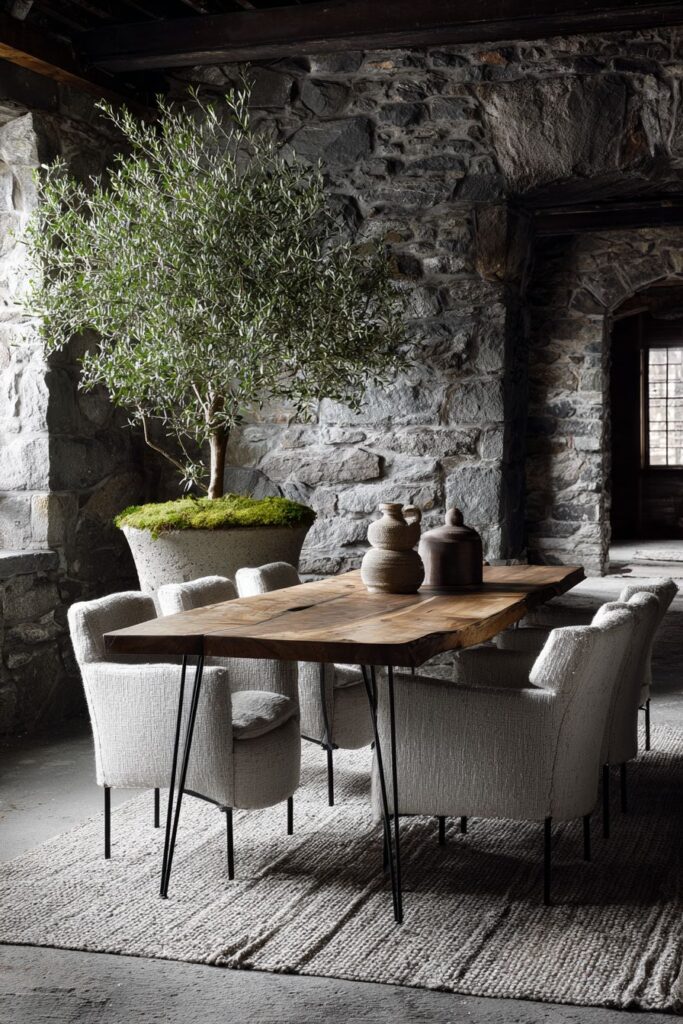
The solid wood dining table made from reclaimed chestnut provides a beautiful counterpoint to the stone wall’s rough texture. Chestnut wood offers rich, warm tones ranging from honey to deep brown, with distinctive grain patterns that create visual interest across the table’s surface. The metal hairpin legs add a subtle industrial touch that keeps the design from feeling too rustic while maintaining the honest, authentic aesthetic that defines natural interiors.
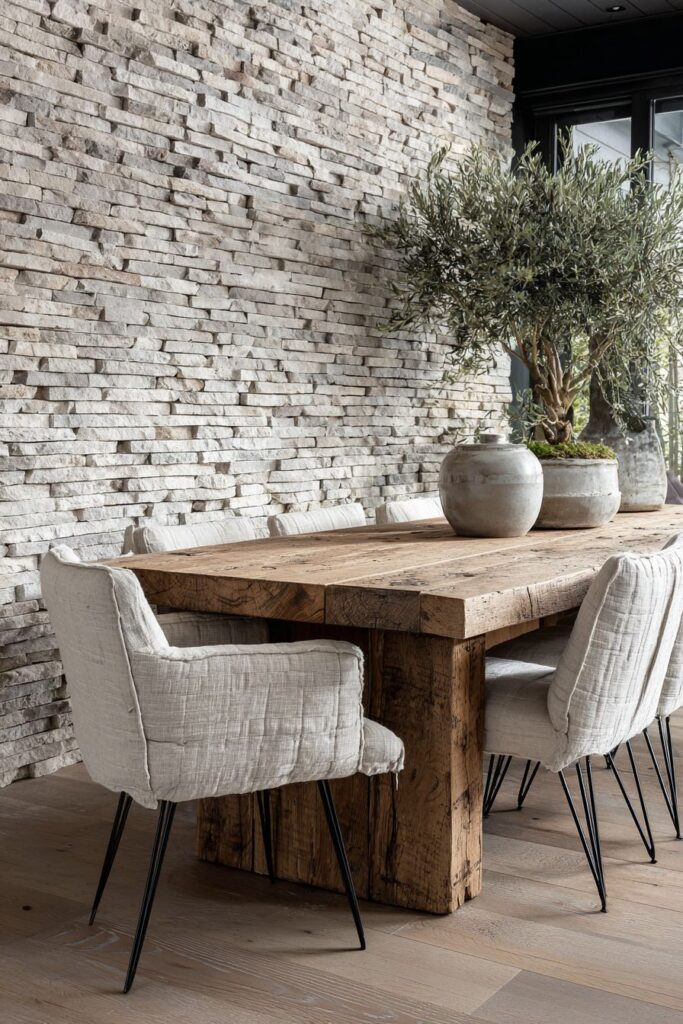
Upholstered dining chairs in natural linen fabric surround the table, their soft texture and neutral coloring providing visual rest from the more dramatic stone and wood elements. The linen’s organic texture and slightly rumpled appearance add to the relaxed, lived-in feeling that makes natural dining rooms so inviting. The neutral coloring ensures the chairs complement rather than compete with the room’s star materials.
A large indoor olive tree in a ceramic planter serves as a living sculpture, its silvery-green leaves and gnarled trunk adding organic form and movement to the space. The olive tree’s Mediterranean associations reinforce the natural, earth-connected aesthetic while providing air purification and the psychological benefits of indoor greenery.
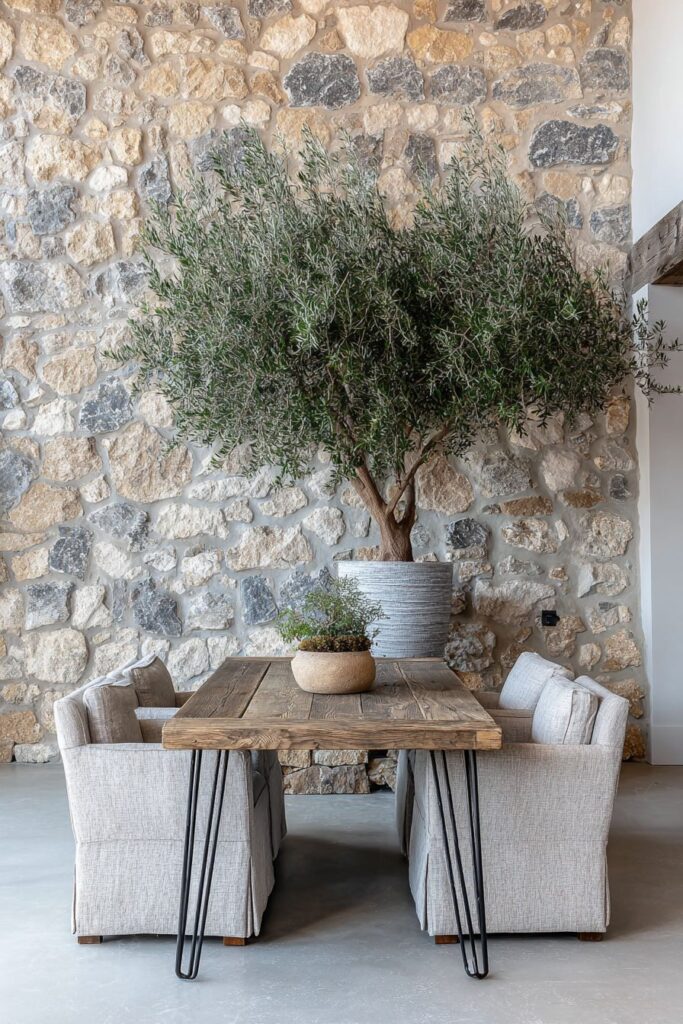
Key Design Tips:
- Combine different natural textures like stone and wood for visual depth
- Choose reclaimed materials for character and environmental sustainability
- Use neutral upholstery to balance dramatic architectural elements
- Add large plants as living sculpture and air purification
- Include subtle industrial elements to prevent overly rustic appearance
7. Vintage Hutch Corner with Artisanal Displays
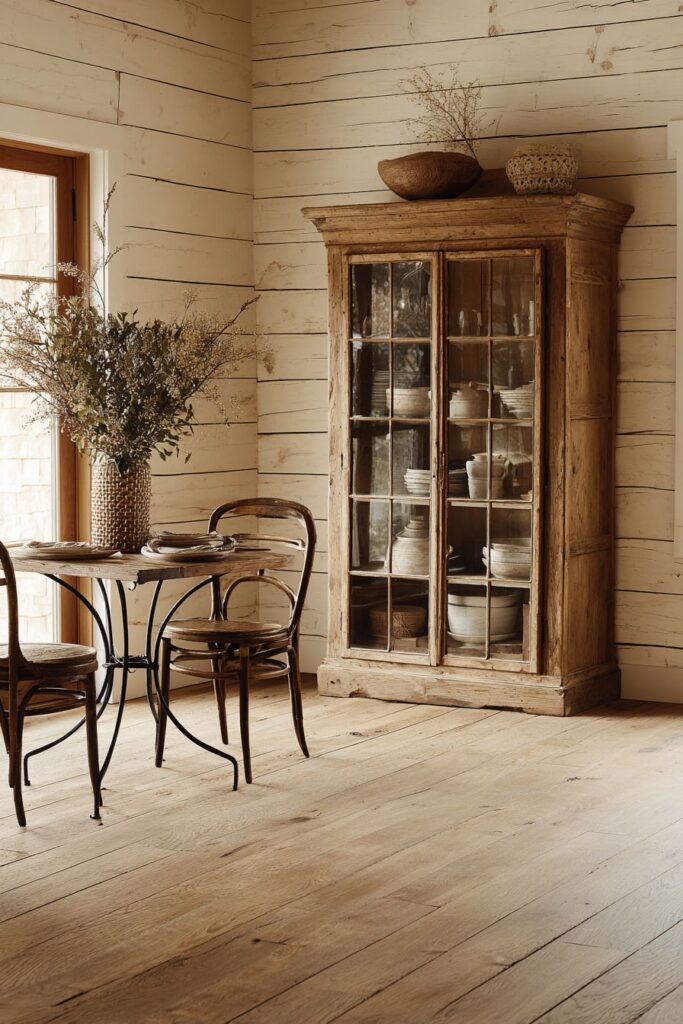
This charming natural dining room corner showcases how vintage furniture can become the foundation for displaying treasured collections of handcrafted objects. The vintage wooden hutch with glass doors serves as both storage and display case, allowing beautiful handcrafted pottery and wooden serving pieces to become part of the room’s decoration. The hutch’s aged wood finish and traditional construction methods reflect craftsmanship values that align perfectly with the natural design aesthetic.
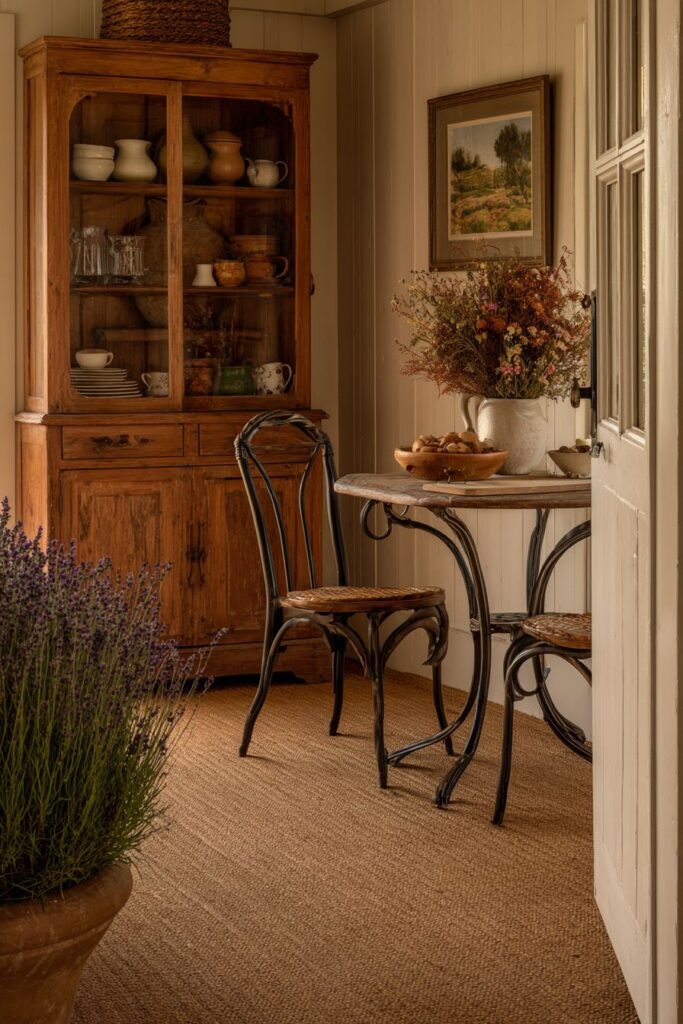
The shiplap walls in natural white oak finish provide a clean, sophisticated backdrop that allows the displayed objects to shine while maintaining the organic material palette. The linear pattern of the shiplap adds subtle texture and visual interest without overwhelming the space, while the natural wood finish brings warmth and character that painted walls simply cannot match.
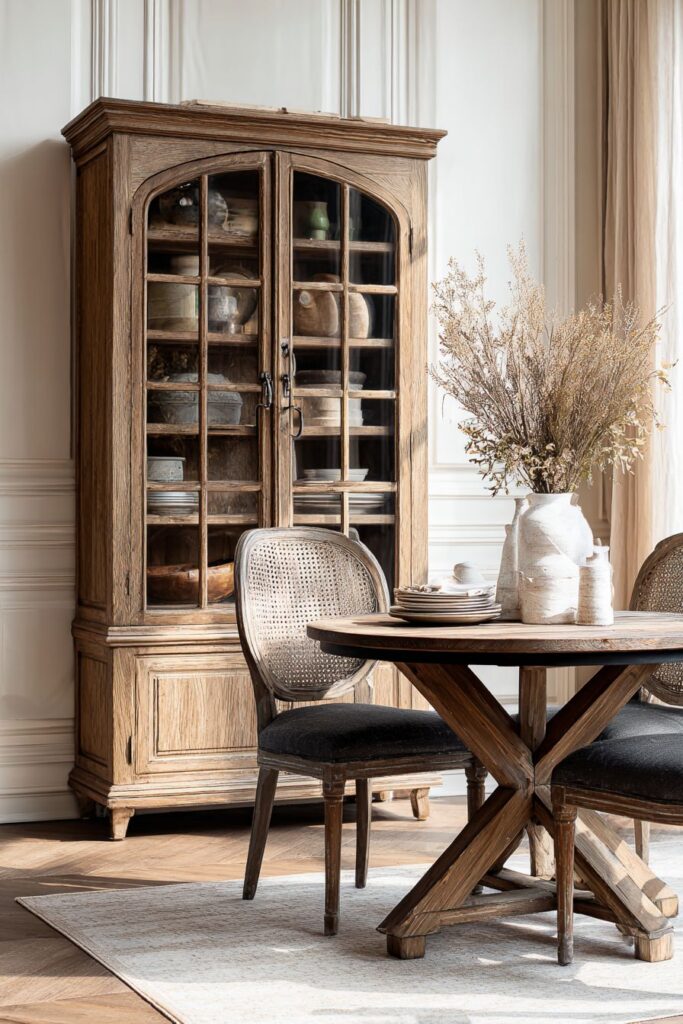
A small bistro table with a wrought iron base and reclaimed wood top creates an intimate seating area perfect for morning coffee or afternoon tea. The combination of metal and wood reflects the honest materials approach of natural design, while the compact scale makes efficient use of the corner space. Two rush-seat chairs provide comfortable seating while adding another natural texture to the material palette.
Dried flower arrangements in ceramic vases add organic elements that change with the seasons while requiring minimal maintenance. These natural displays connect the interior space with the rhythms of nature while providing color and textural interest. The ceramic vessels themselves become part of the artisanal collection, showcasing the hand-formed irregularities that make handcrafted objects so appealing.
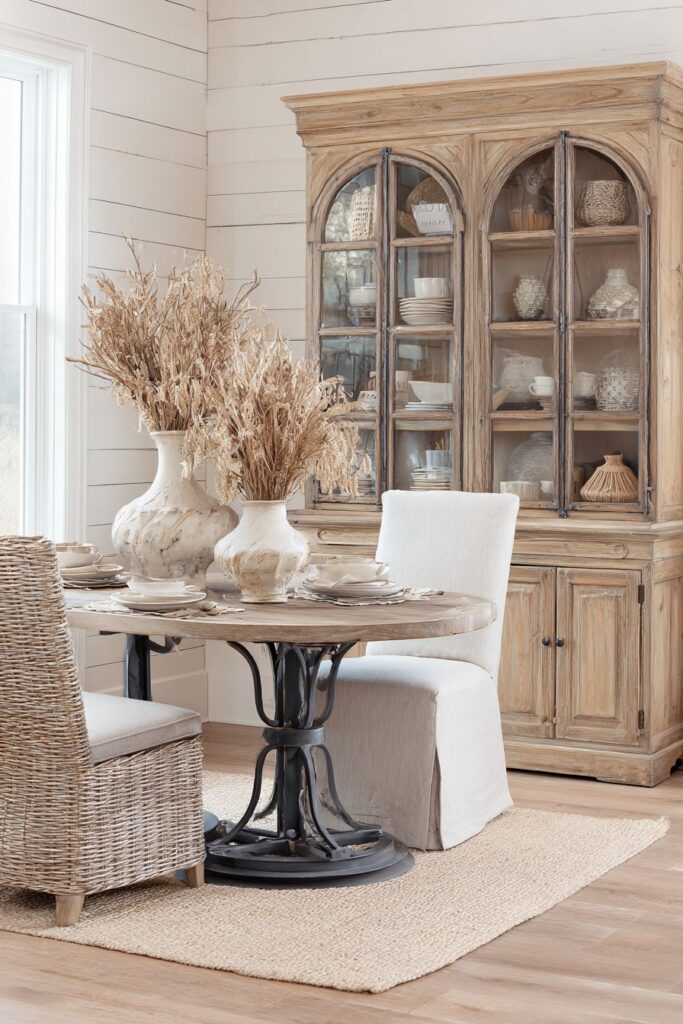
Key Design Tips:
- Use vintage furniture as display cases for treasured collections
- Choose natural wood wall treatments over painted surfaces when possible
- Create intimate seating areas in unused corners for added functionality
- Display dried flowers for low-maintenance natural beauty
- Collect handcrafted objects that tell stories and show maker’s marks
8. Floor-to-Ceiling Windows with Garden Views
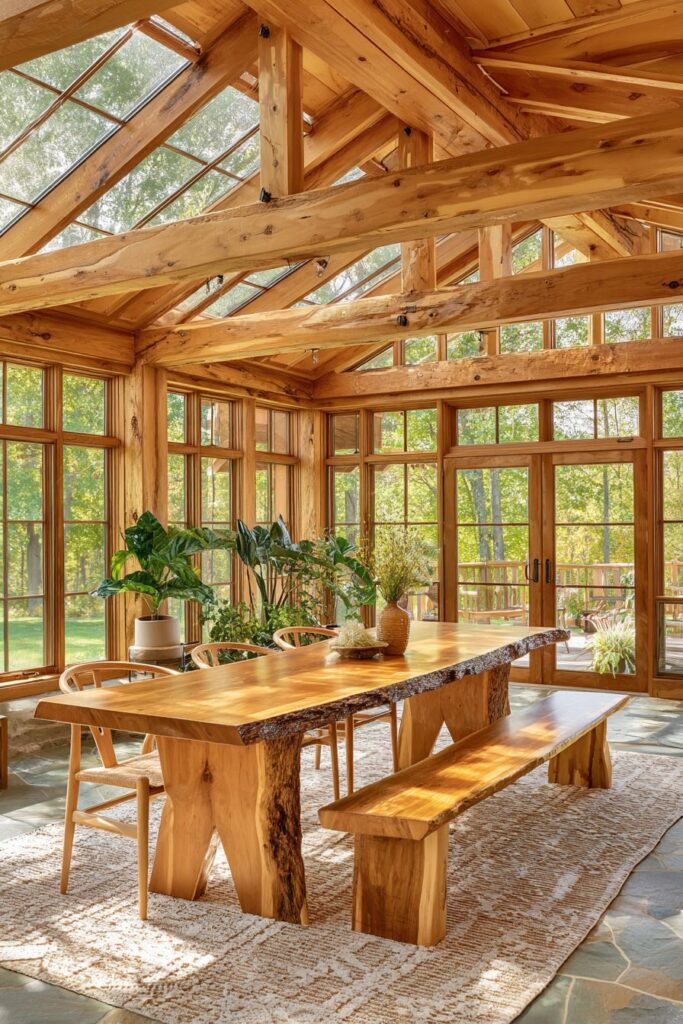
This breathtaking natural dining room demonstrates the powerful impact of connecting interior spaces with outdoor landscapes through thoughtful window design. Floor-to-ceiling windows framed in natural wood create an almost seamless transition between inside and outside, making the garden view an integral part of the dining experience. The natural wood frames add warmth and character while maintaining visual connection with the organic materials used throughout the interior space.
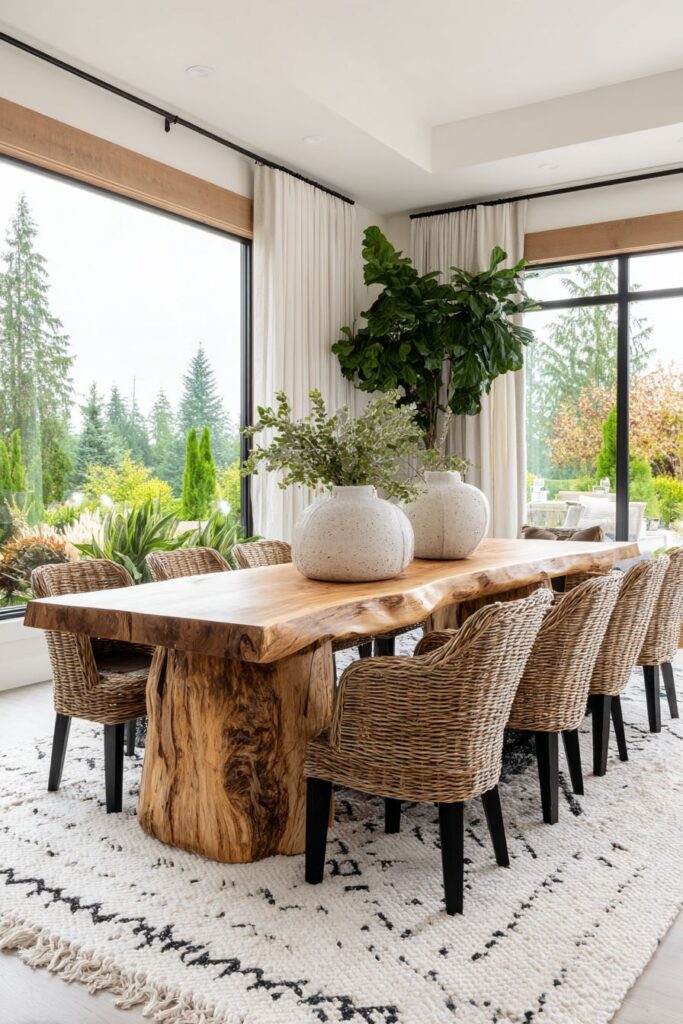
The live-edge maple dining table serves as a magnificent centerpiece, its raw edges and distinctive grain patterns creating a direct connection to nature’s artistry. Maple wood offers beautiful color variation from pale cream to rich amber, with grain patterns that seem to flow like water across the surface. The live edge preserves the tree’s natural form, making each table truly one-of-a-kind and celebrating the raw beauty found in nature.
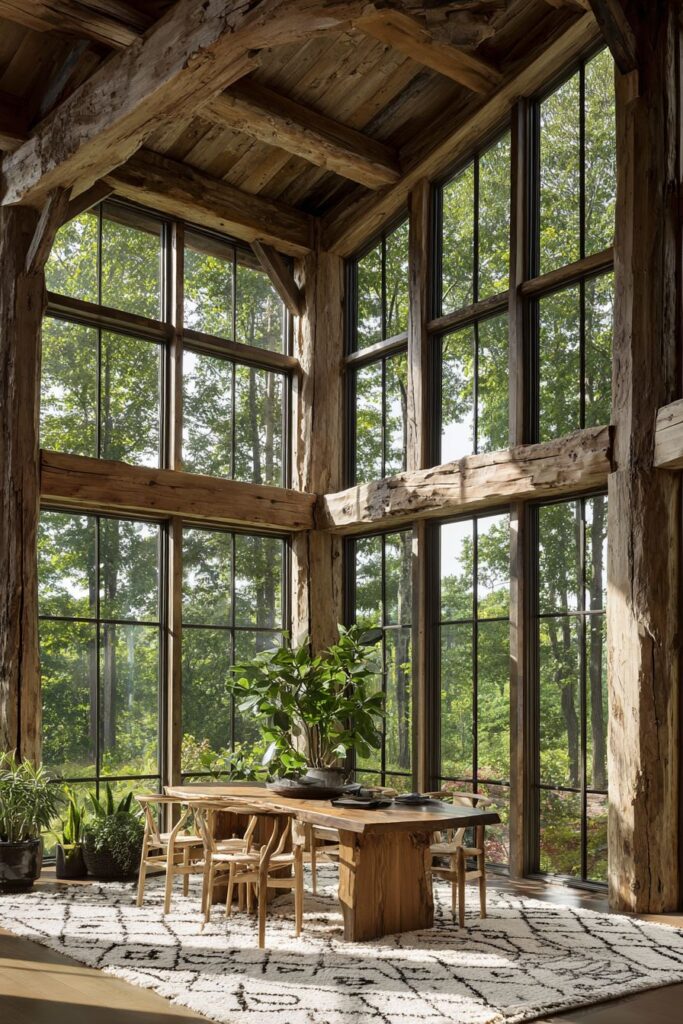
Bentwood chairs in natural finish surround the table, their curved forms created through traditional steam-bending techniques that showcase wood’s remarkable flexibility and strength. The natural finish allows the wood’s character to show through while the ergonomic curves provide comfortable seating for long meals. The consistent material palette creates visual harmony while each piece maintains its individual character.
A jute area rug with subtle geometric patterns provides grounding for the seating arrangement while adding textural interest through its natural fiber construction. The neutral coloring and organic material ensure the rug enhances rather than competes with the stunning wood furniture and garden views. Strategically placed plants including snake plants and peace lilies bring additional greenery indoors while connecting with the outdoor landscape visible through the windows.
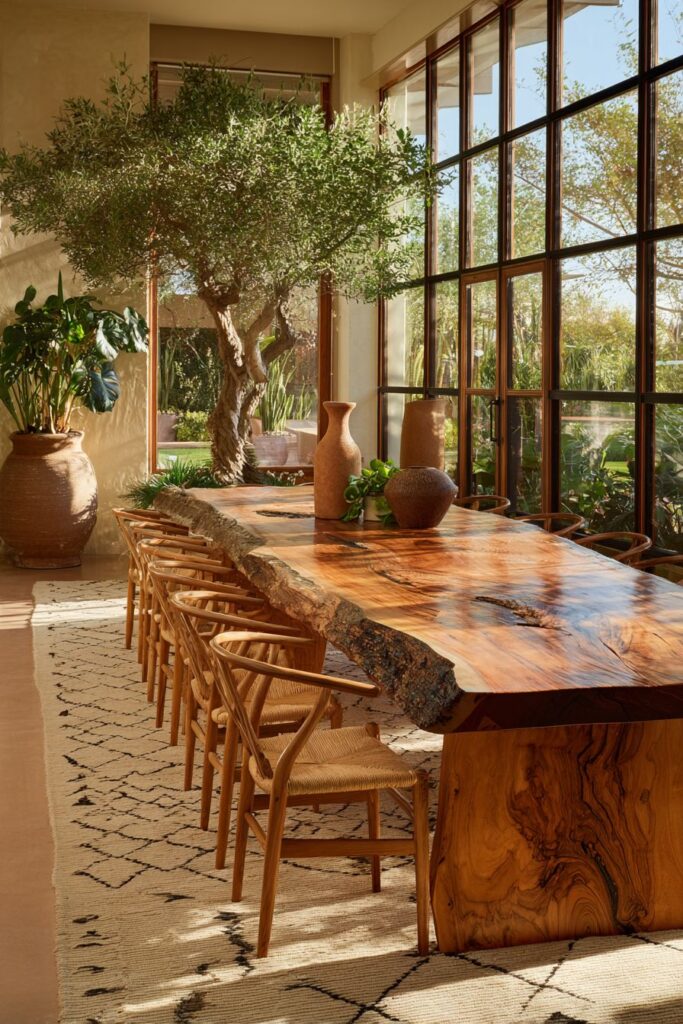
Key Design Tips:
- Maximize window size to blur boundaries between indoor and outdoor spaces
- Choose live-edge furniture to celebrate wood’s natural form
- Use consistent material palettes for visual harmony
- Select natural fiber rugs for texture without visual competition
- Include plants that thrive in bright light near large windows
9. Weathered Oak Trestle Table with Mortise and Tenon Details
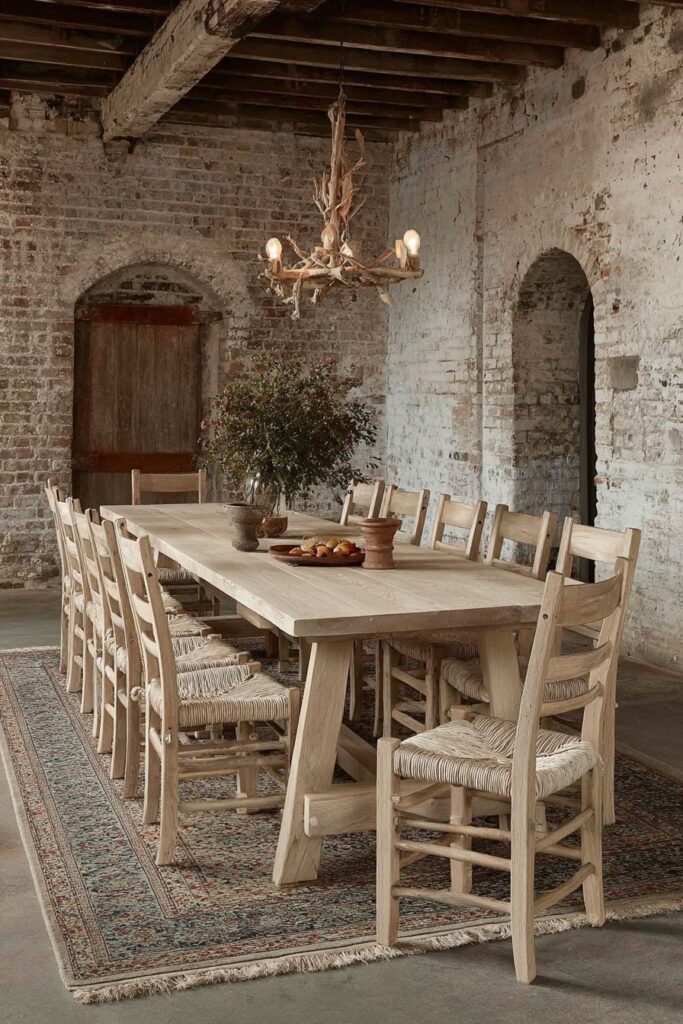
This authentic natural dining room celebrates traditional woodworking techniques and the beautiful patina that develops over time. The trestle-style dining table crafted from weathered oak showcases visible mortise and tenon joinery, allowing diners to appreciate the skill and craftsmanship that went into its construction. The weathered oak surface tells stories of decades of use, with gentle wear patterns and color variations that create depth and character impossible to achieve with new materials.
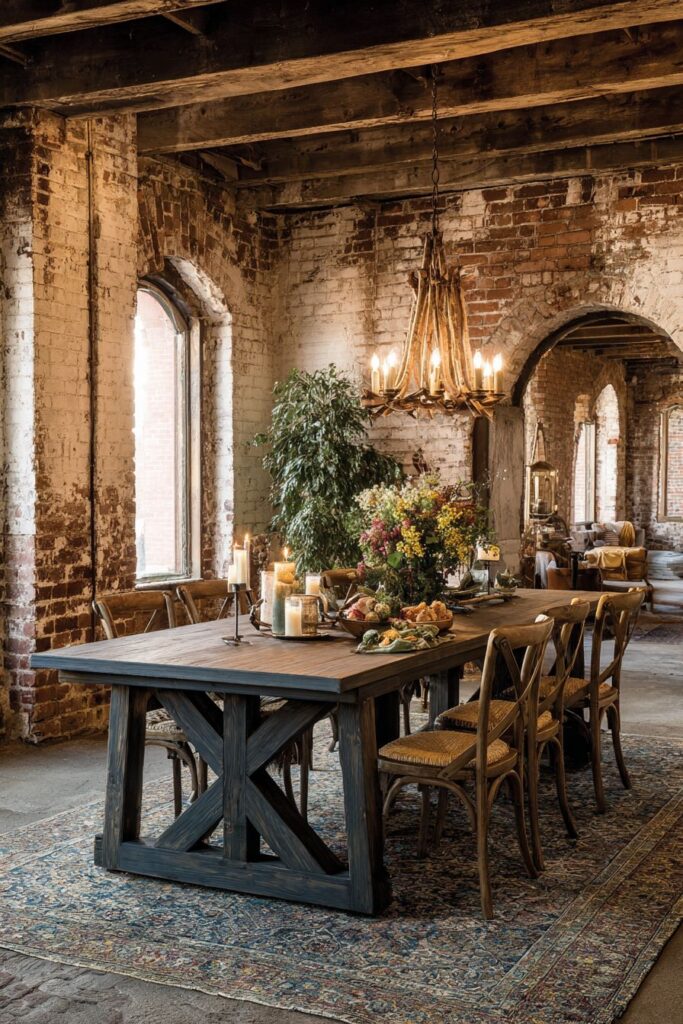
Ladderback chairs with woven rush seats surround the table, each showing natural color variations that come from the organic materials and traditional construction methods. The rush seats develop beautiful patina over time, becoming more comfortable and visually appealing with age. The ladder-back design represents centuries of refinement in chair construction, proving that functional beauty never goes out of style.
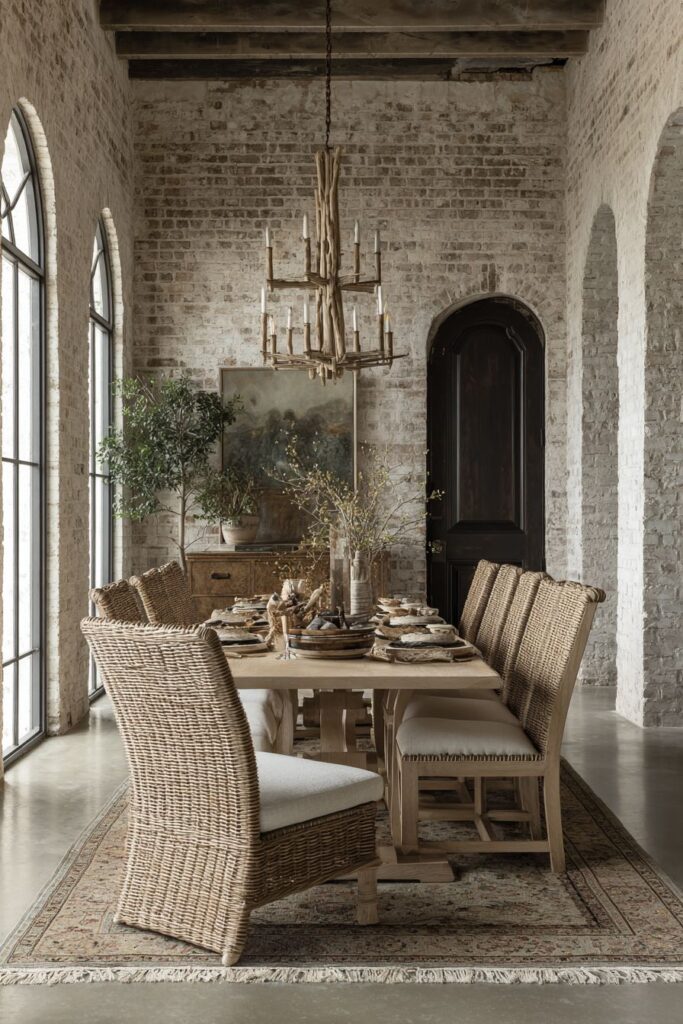
Above this gathering place, a unique chandelier made from driftwood and Edison bulbs creates dramatic lighting that reinforces the connection to natural materials. The driftwood’s sculptural form, shaped by years of wave action and weathering, becomes functional art that provides warm, intimate lighting. Edison bulbs add vintage character while their warm light enhances the rich wood tones throughout the space.
Exposed brick walls painted in soft white provide textural interest while maintaining the natural material palette. The brick’s irregular surface and varied coloring add depth and character, while the soft white paint brightens the space without masking the material’s inherent texture. A vintage Persian rug in muted earth tones grounds the seating area while adding patterns and colors that complement the wood and brick elements.

Key Design Tips:
- Celebrate visible joinery and craftsmanship details in furniture selection
- Choose materials that improve with age and develop natural patina
- Use architectural salvage like driftwood for unique lighting solutions
- Paint brick walls in light colors to brighten while preserving texture
- Select vintage rugs in earth tones to complement natural materials
10. Window Seat Nook with Burled Walnut Round Table
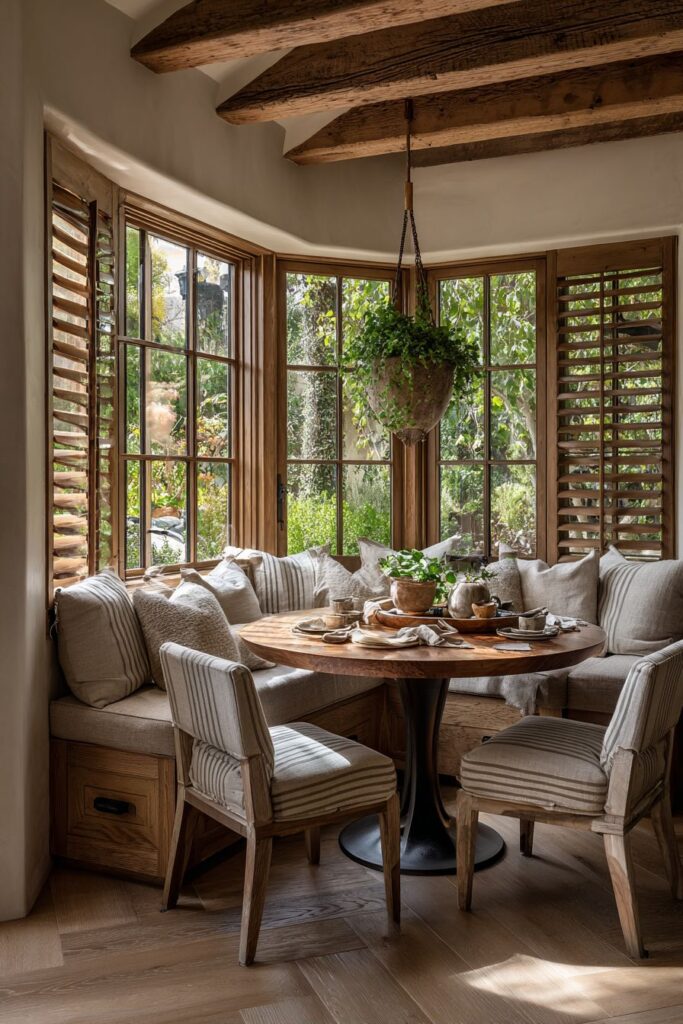
This inviting natural dining room features a built-in window seat that transforms dining into a cozy, intimate experience. The window seat features natural linen cushions and throw pillows made from organic cotton, creating a comfortable gathering spot that encourages lingering conversation. The organic cotton and linen materials provide breathability and comfort while their neutral tones complement the natural wood elements throughout the space.
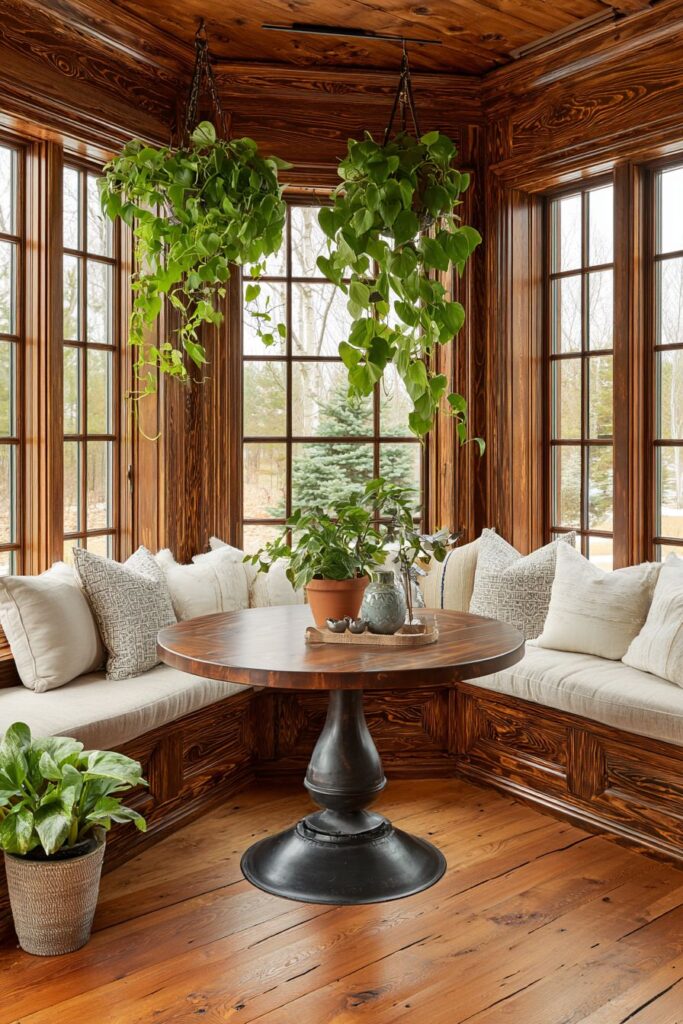
Positioned beneath casement windows with natural wood frames, the window seat takes full advantage of natural light and outdoor views while providing flexible seating that can accommodate various group sizes. The natural wood window frames add architectural character while maintaining the organic material palette that defines the space. Casement windows provide excellent ventilation and unobstructed views that strengthen the connection between interior and exterior spaces.
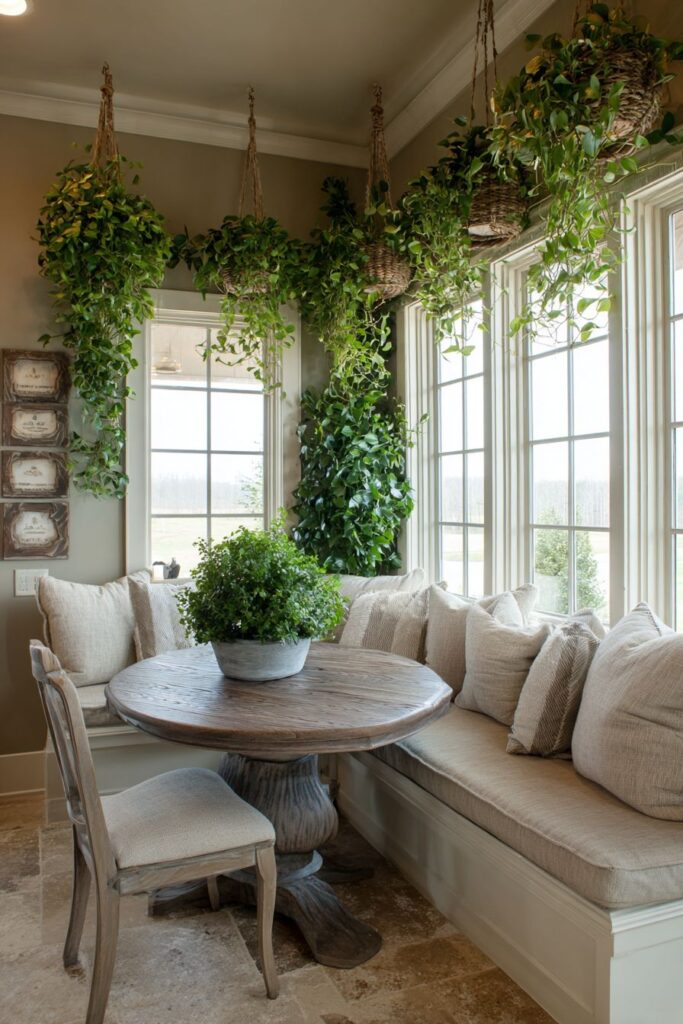
The round dining table made from burled walnut with a metal pedestal base serves as a stunning centerpiece that showcases one of nature’s most dramatic wood grain patterns. Burled wood forms when a tree experiences stress or injury, creating swirling, complex grain patterns that are highly prized for their beauty and rarity. The metal pedestal base provides stable support while creating visual lightness that prevents the table from overwhelming the intimate space.
Hanging planters with trailing pothos add vertical green elements that maintain the natural aesthetic while providing air purification benefits. The cascading foliage creates organic movement and softens hard edges while requiring minimal maintenance. This living element connects the interior space with nature while adding the psychological benefits of indoor plants.
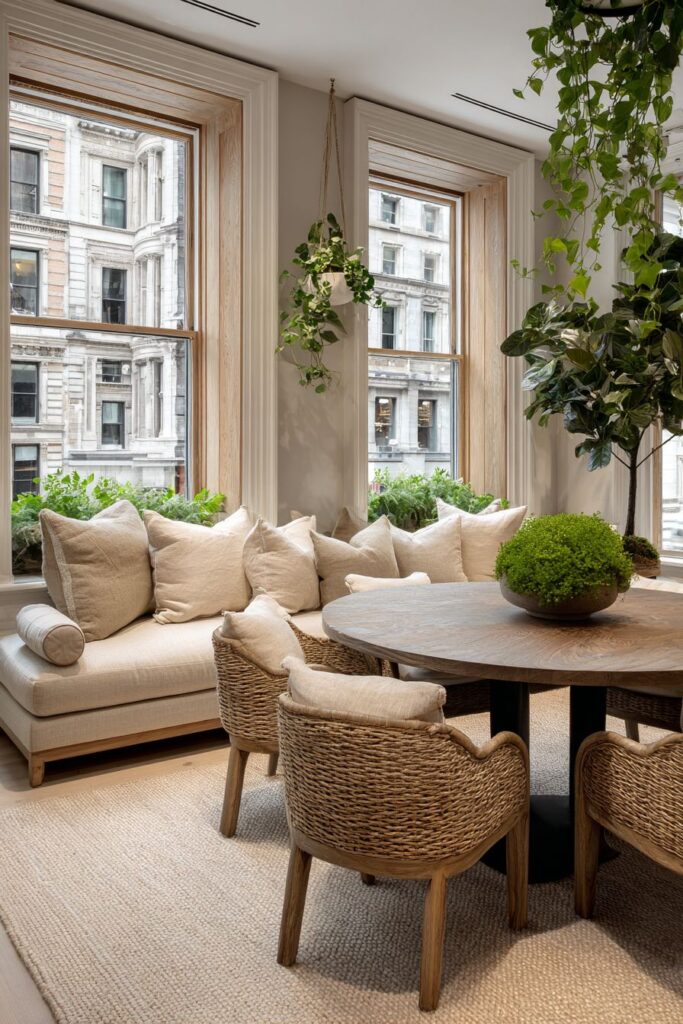
Key Design Tips:
- Create window seats to maximize seating while connecting with outdoor views
- Use organic fabrics for comfort and environmental responsibility
- Choose unique wood grains like burled patterns for statement pieces
- Add hanging plants to incorporate vertical greenery without floor space
- Select round tables for intimate dining and better conversation flow
11. Single Slab Elm Table with Botanical Art Gallery
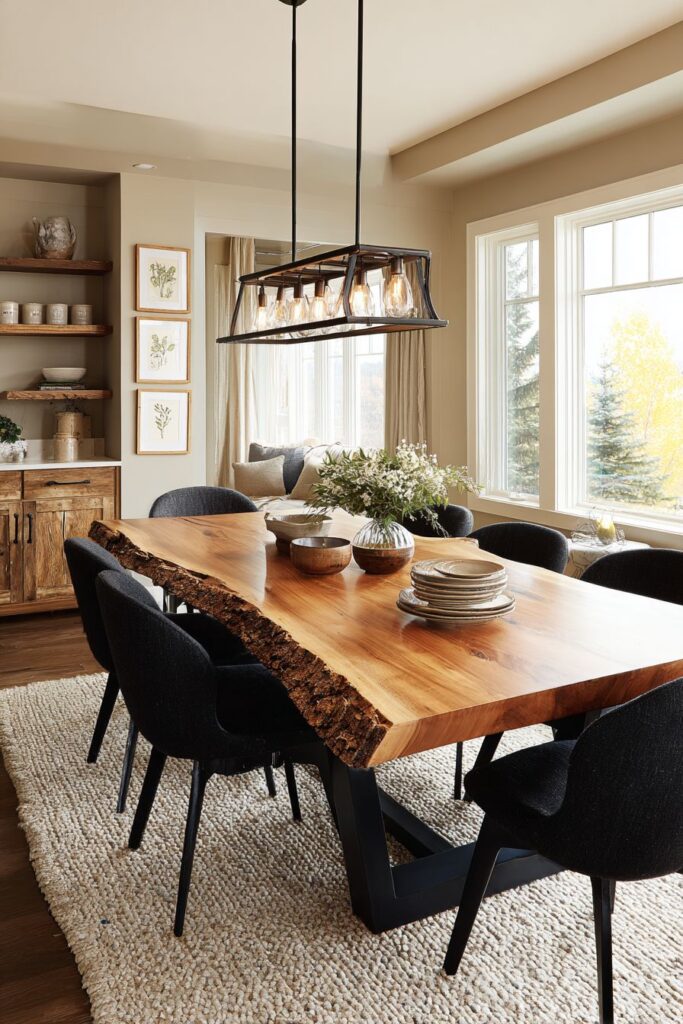
This sophisticated natural dining room centers around an extraordinary dining table crafted from a single slab of elm wood with bark edge detail intact. This remarkable piece of furniture showcases the full diameter of the original tree, complete with natural bark inclusions and growth patterns that tell the story of decades of growth and seasonal change. The bark edge detail adds incredible authenticity and natural beauty that simply cannot be replicated with manufactured materials.
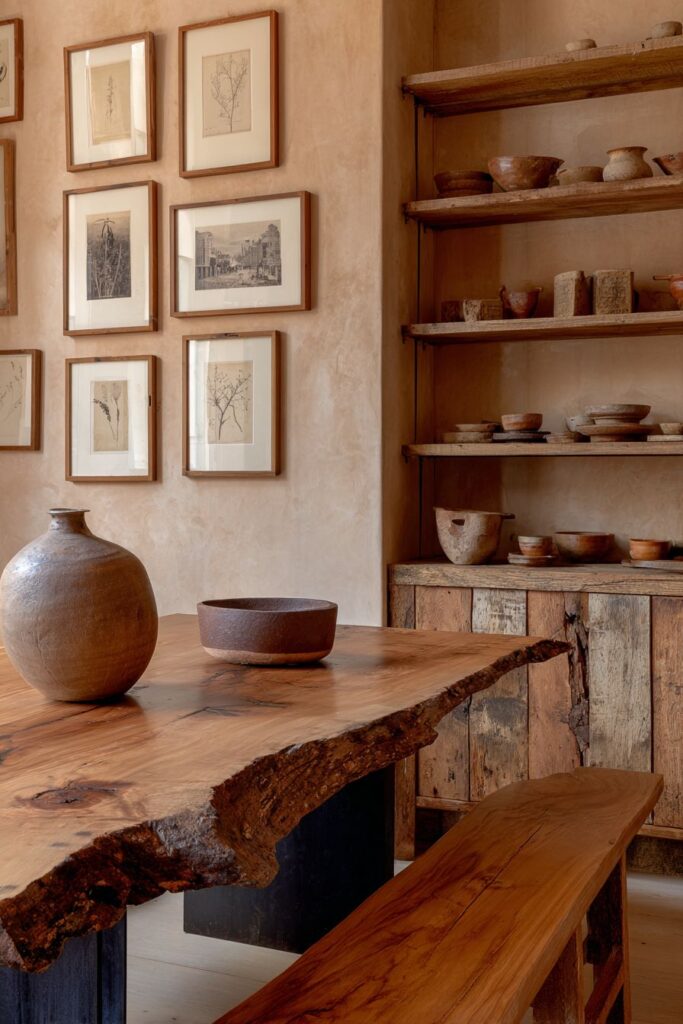
Supported by sleek black steel legs, the elm slab creates a stunning contrast between organic and industrial elements that keeps the space feeling contemporary rather than overly rustic. The steel legs provide strong, stable support while their minimal design allows the wood slab to remain the visual focus. This combination of materials represents the best of both natural and manufactured design elements.
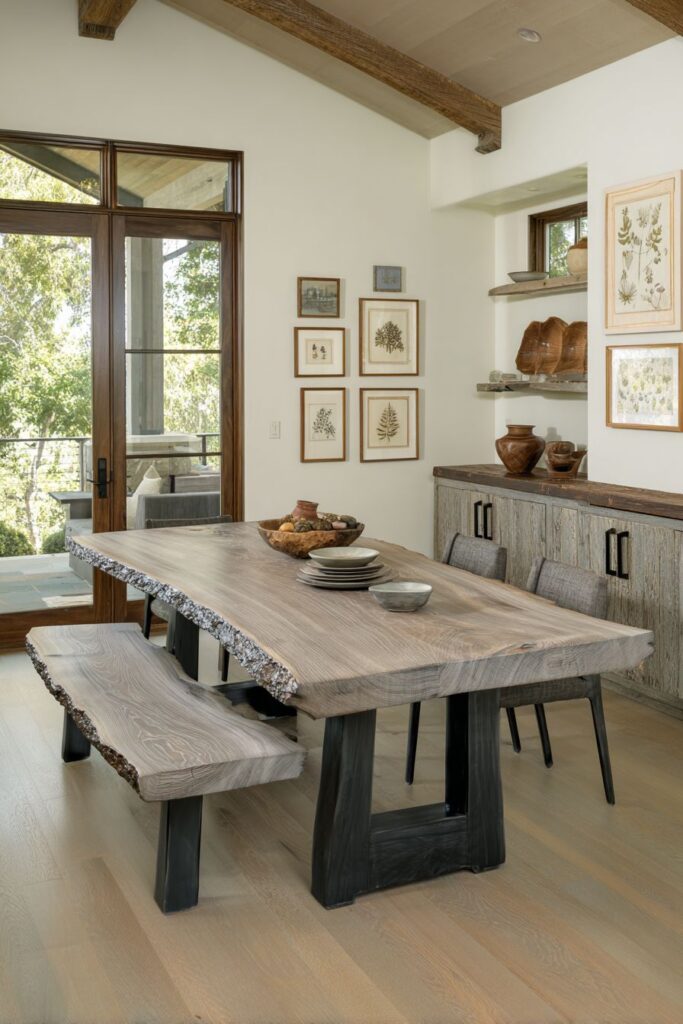
A carefully curated gallery wall of botanical prints in natural wood frames creates an educational and artistic backdrop that reinforces the connection to nature. These scientific illustrations celebrate the intricate beauty of plant forms while providing year-round botanical interest. The natural wood frames tie into the material palette while the varied print sizes create dynamic visual composition.
The sideboard made from reclaimed pine displays the honest character marks that make salvaged materials so appealing. Visible nail holes, weathering, and color variations tell the story of the wood’s previous life while providing practical storage for dining essentials. Ceramic serving pieces in earth tones displayed on open shelving continue the natural color palette while providing functional beauty.
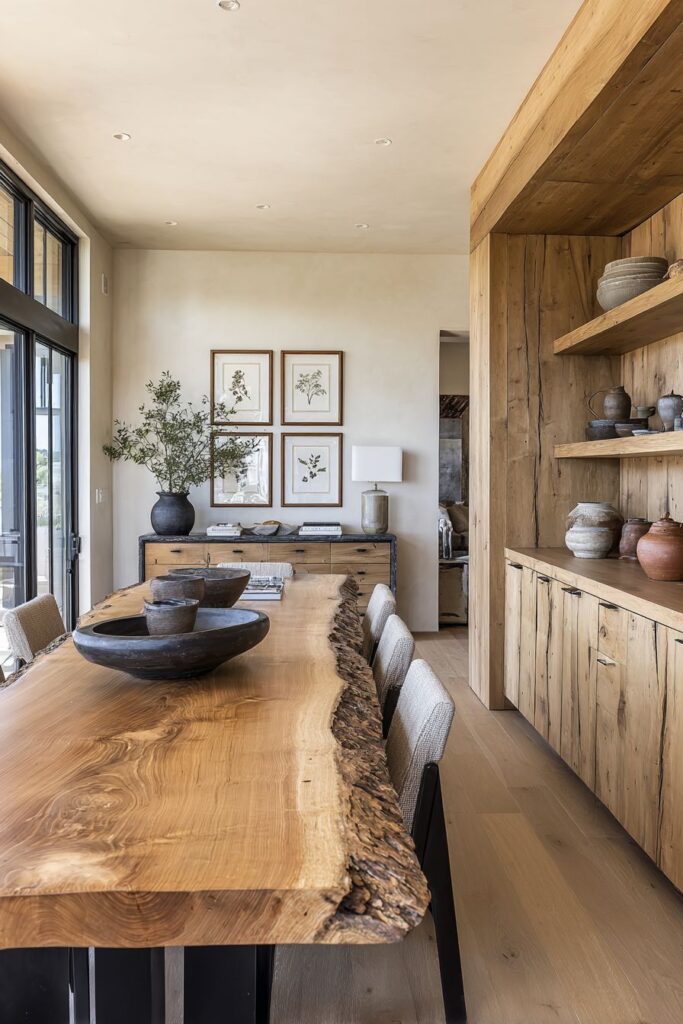
Key Design Tips:
- Seek out unique wood slabs that preserve bark edges and natural character
- Balance organic materials with industrial elements for contemporary appeal
- Create botanical art galleries using scientific prints and natural frames
- Display functional ceramics as decorative elements on open shelving
- Choose reclaimed materials that show honest wear and character marks
12. Vaulted Ceiling with Cedar Trusses and Stone Fireplace
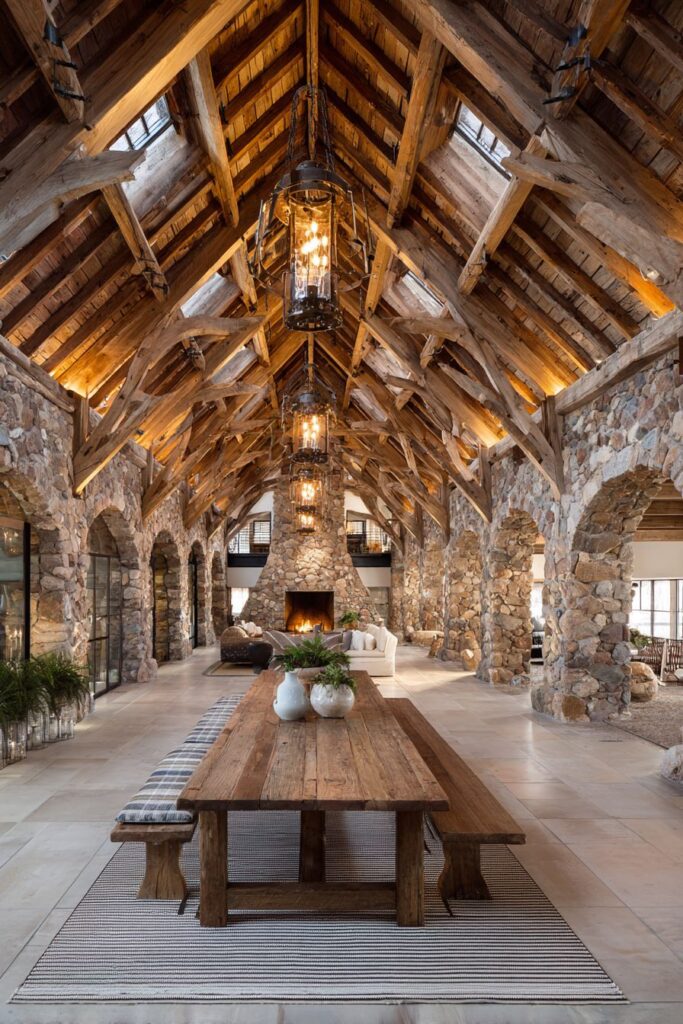
This dramatic natural dining room showcases how architectural elements can create stunning backdrop for organic design. The vaulted ceilings with exposed wooden trusses in natural cedar finish draw the eye upward while creating a sense of grandeur and connection to traditional building techniques. Cedar’s natural resistance to insects and decay makes it practical for exposed applications, while its distinctive grain patterns and warm coloring add visual interest and aromatic qualities.
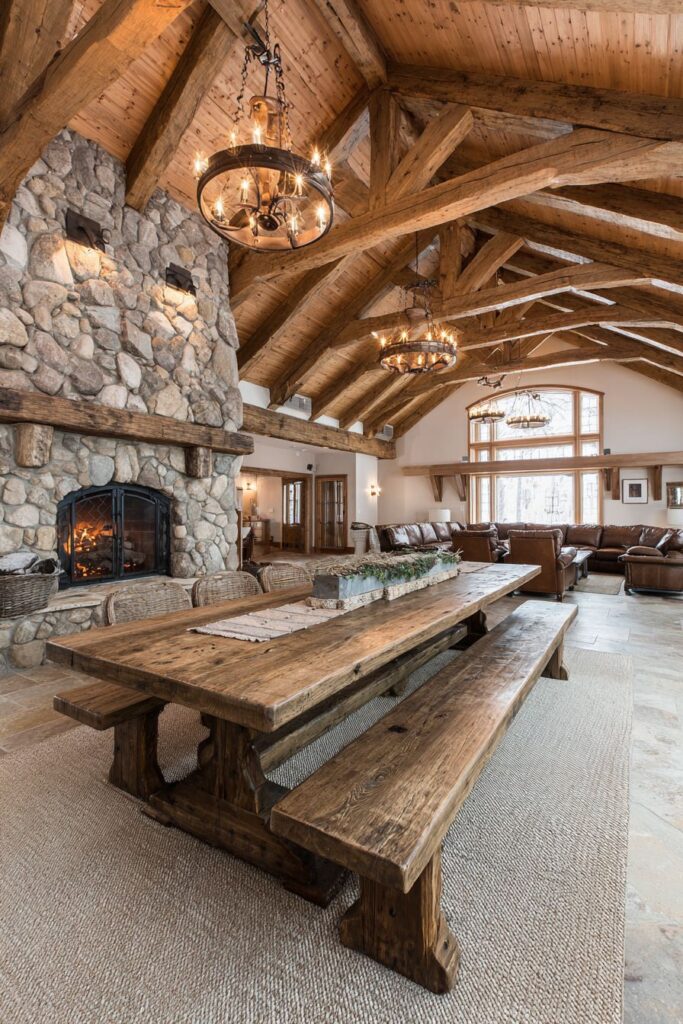
The large harvest table made from reclaimed barn wood serves as the room’s commanding centerpiece, its generous proportions perfect for large gatherings and holiday meals. Reclaimed barn wood carries the patina and character marks of decades of agricultural use, with nail holes, weathering, and color variations that cannot be replicated with new materials. Bench seating on one side maximizes seating capacity while maintaining clean sight lines across the space.
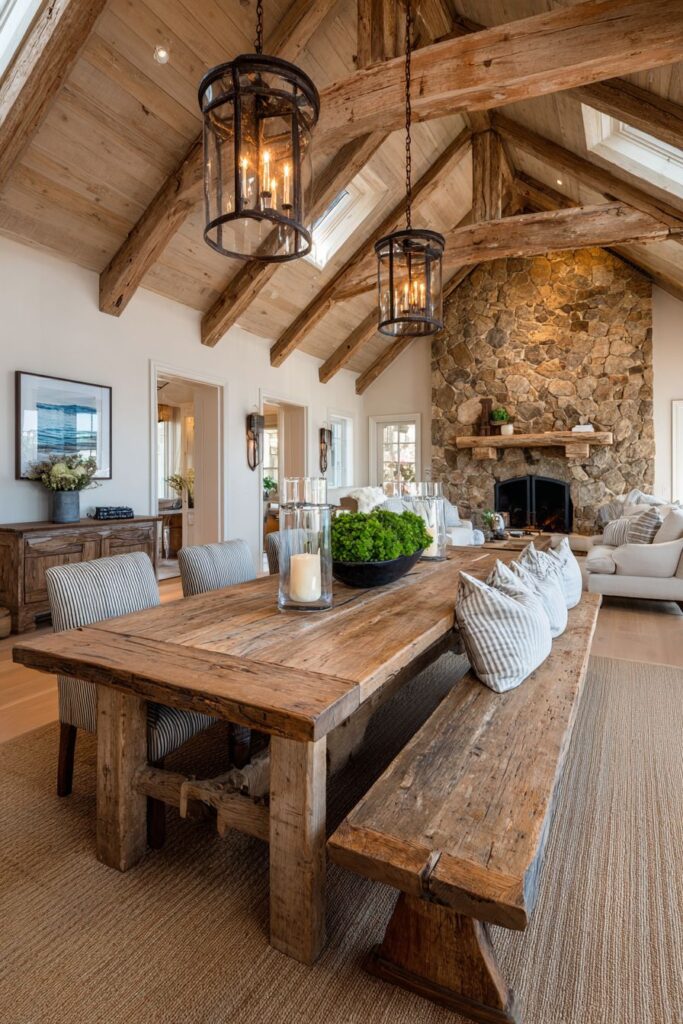
The stone fireplace with natural fieldstone surround creates a dramatic focal point that provides both visual weight and cozy ambiance during cooler months. Each fieldstone is unique in size, color, and texture, creating a complex composition that brings the rugged beauty of natural landscapes indoors. The fireplace becomes a gathering point that extends the dining room’s functionality beyond meal times.
A jute area rug with subtle striped pattern provides definition for the seating area while its natural fiber construction maintains the organic aesthetic. The striped pattern adds subtle visual interest without competing with the dramatic architectural elements, while the neutral coloring complements the rich wood and stone tones throughout the space.
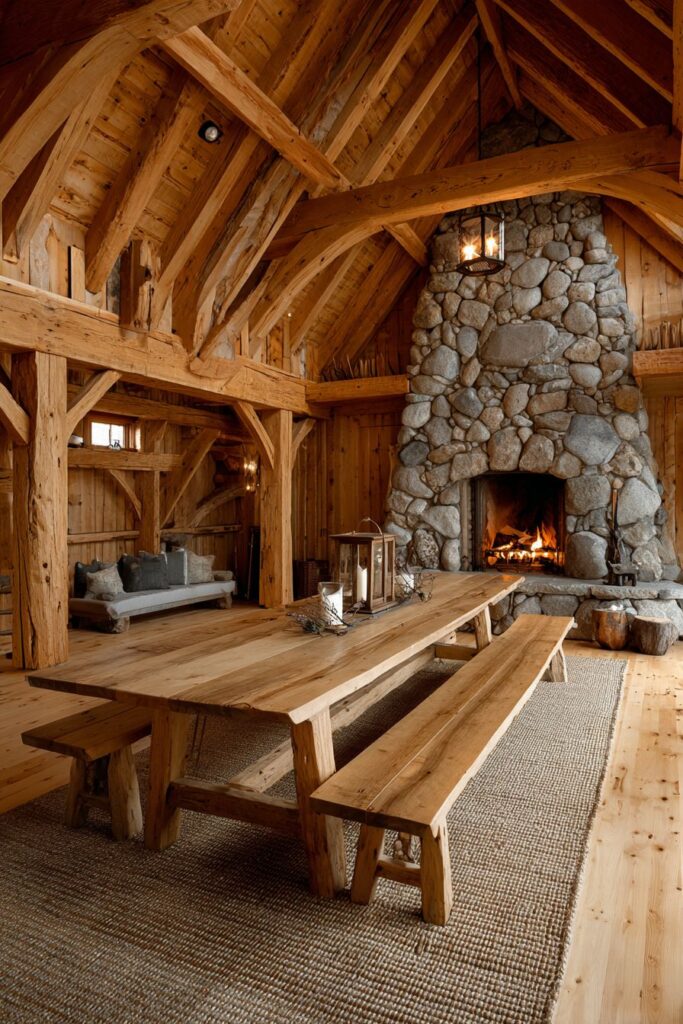
Key Design Tips:
- Use exposed ceiling trusses to add architectural drama and traditional character
- Choose harvest tables for generous proportions and community dining appeal
- Include fireplaces as secondary focal points for year-round gathering spaces
- Select natural stone materials that showcase geological diversity and beauty
- Use jute rugs with subtle patterns to define spaces without visual competition
13. Modular Oak Dining Set with Flexible Functionality

This practical natural dining room demonstrates how modern functionality can coexist beautifully with organic materials and traditional craftsmanship. The extendable oak table with butterfly leaf mechanism showcases the wood’s stunning grain variations while providing flexible sizing for different occasions. The butterfly leaf system represents ingenious traditional joinery that allows the table to expand seamlessly while maintaining structural integrity and visual continuity.
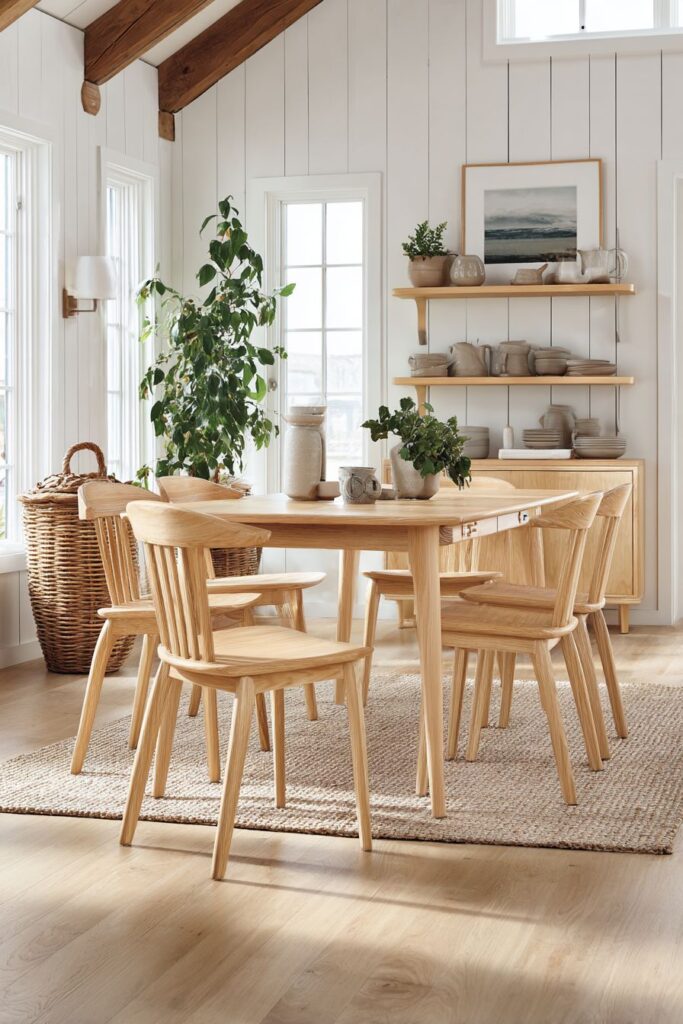
Stackable wooden chairs with natural finish offer practical storage solutions without sacrificing beauty or comfort. Each chair shows subtle wood grain variations that come from natural growth patterns, making every seat unique while maintaining visual harmony across the set. The stackable design makes it easy to store extra chairs when not needed, perfect for modern living situations where space efficiency matters.
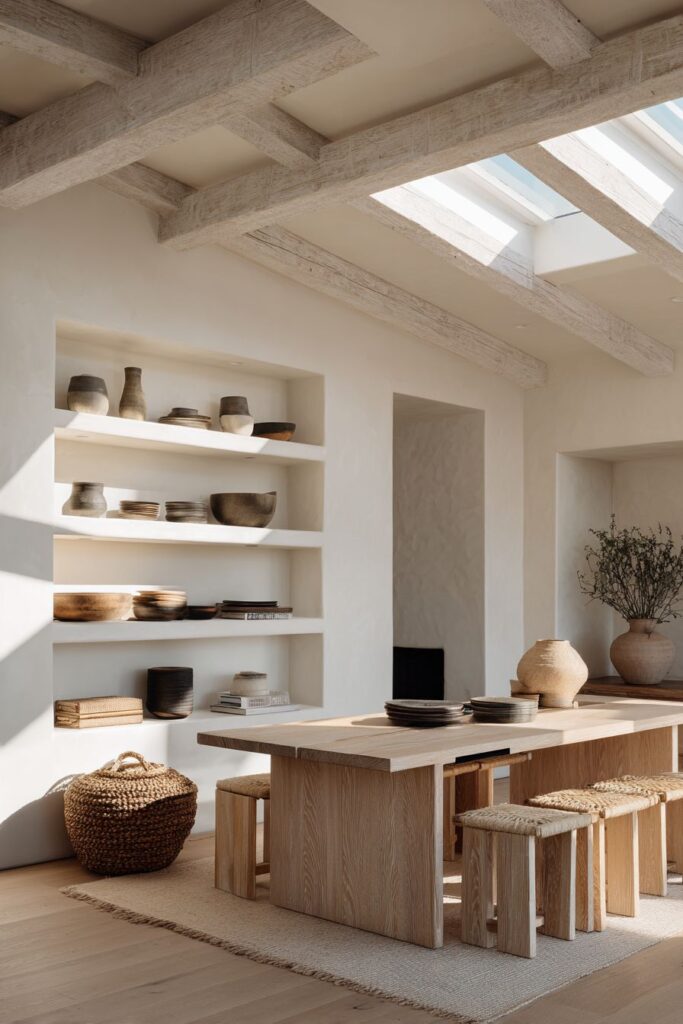
Wall-mounted floating shelves display ceramic dinnerware in neutral glazes that complement the natural wood tones while providing easy access to everyday essentials. The neutral glazes in cream, sage, and warm grey create a sophisticated color palette that works with seasonal decorating changes while maintaining timeless appeal. The floating shelf design keeps visual lines clean while maximizing storage capacity.
Natural light from skylights creates dynamic shadows that change throughout the day, highlighting the oak’s grain patterns and bringing out the subtle color variations in the ceramic displays. A large woven basket serves as attractive storage for linens, serving pieces, or seasonal items, its natural fiber construction adding textural interest while maintaining the organic aesthetic.
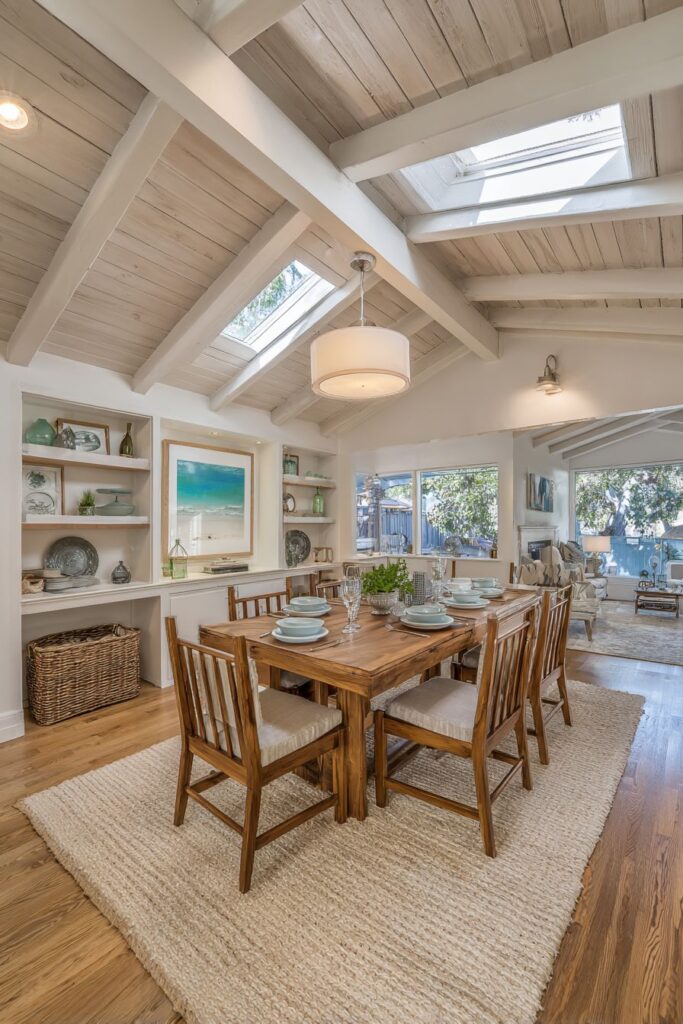
Key Design Tips:
- Choose extendable tables with traditional joinery for flexibility and craftsmanship
- Select stackable seating for space-efficient storage without sacrificing style
- Use neutral ceramic glazes that complement natural wood tones
- Install skylights for dramatic natural lighting and shadow play
- Incorporate woven storage solutions that add texture while hiding clutter
14. Vertical Wood Plank Feature Wall with Maple Pedestal Table

This striking natural dining room showcases how wood can be used architecturally to create stunning visual impact. The statement wall features vertical wood planks in varying widths and natural stain finishes, creating subtle tonal variations that add depth and visual interest. The vertical orientation draws the eye upward while the varied widths prevent the treatment from feeling too uniform or predictable.
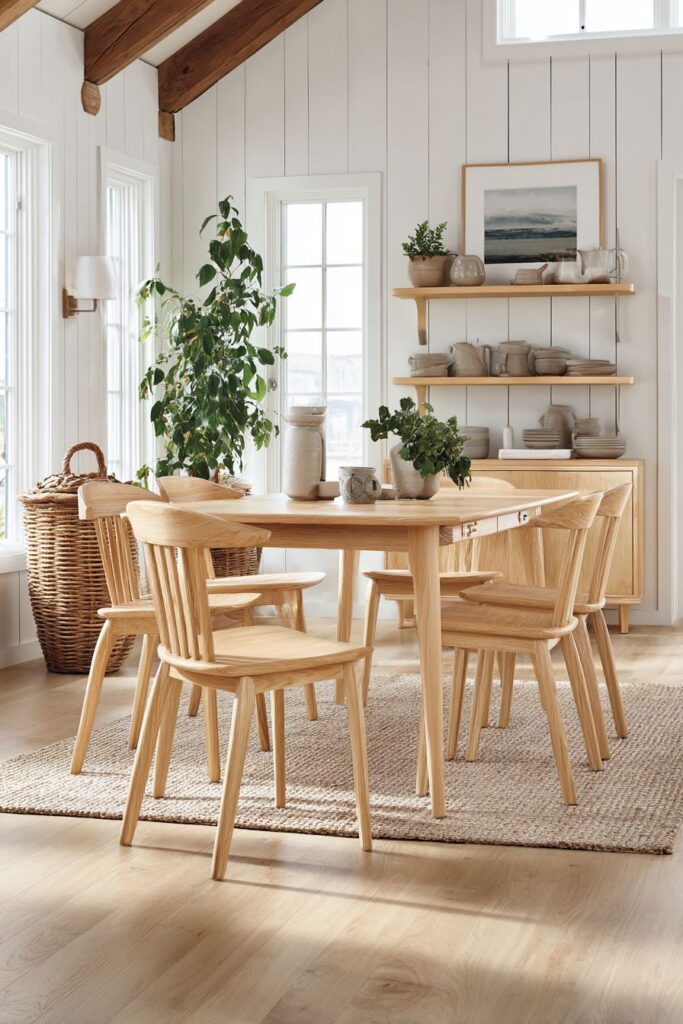
The round pedestal dining table made from solid maple with natural edge detail serves as an elegant counterpoint to the dramatic wall treatment. Maple’s fine, consistent grain creates beautiful patterns across the table surface, while the natural edge detail preserves some of the tree’s original character. The pedestal base maximizes legroom and creates clean sight lines that complement the vertical wall treatment.
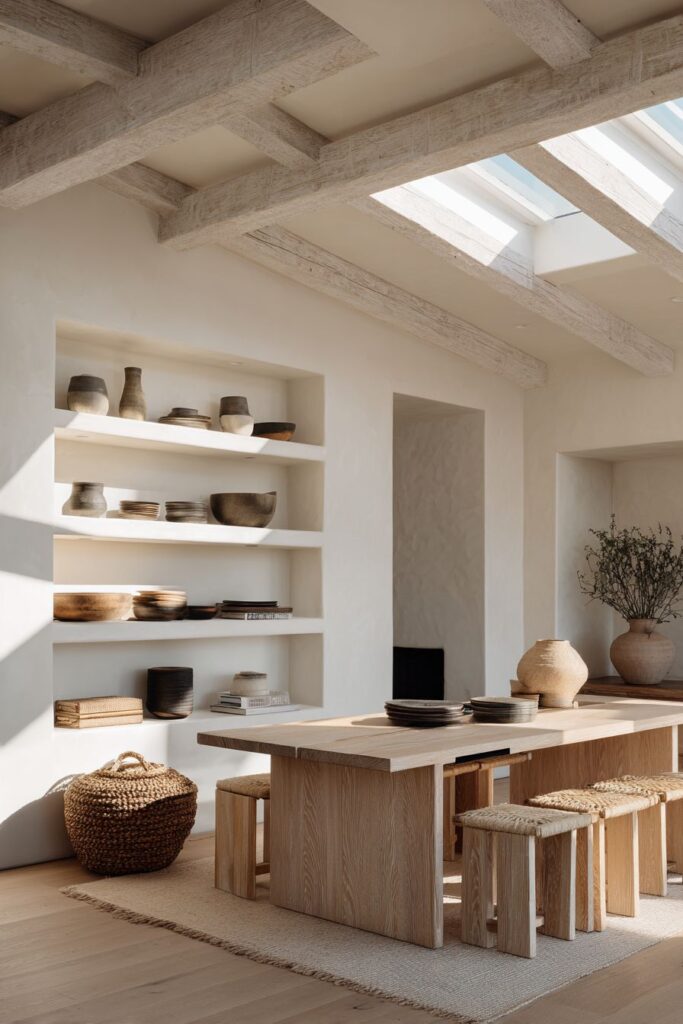
Four spindle-back chairs in matching wood finish provide comfortable seating while reinforcing the natural material palette. The spindle-back design represents traditional chair construction at its finest, with each spindle individually turned and fitted for lasting beauty and comfort. The matching wood finish creates visual continuity while subtle grain variations ensure each chair maintains individual character.
A carefully curated collection of ceramic vessels and wooden bowls displayed on a console table adds functional artistry to the space. These handcrafted objects showcase the beauty of traditional making techniques while providing practical serving pieces for everyday use. The varied shapes, sizes, and glazes create visual interest while maintaining the natural color palette throughout the space.
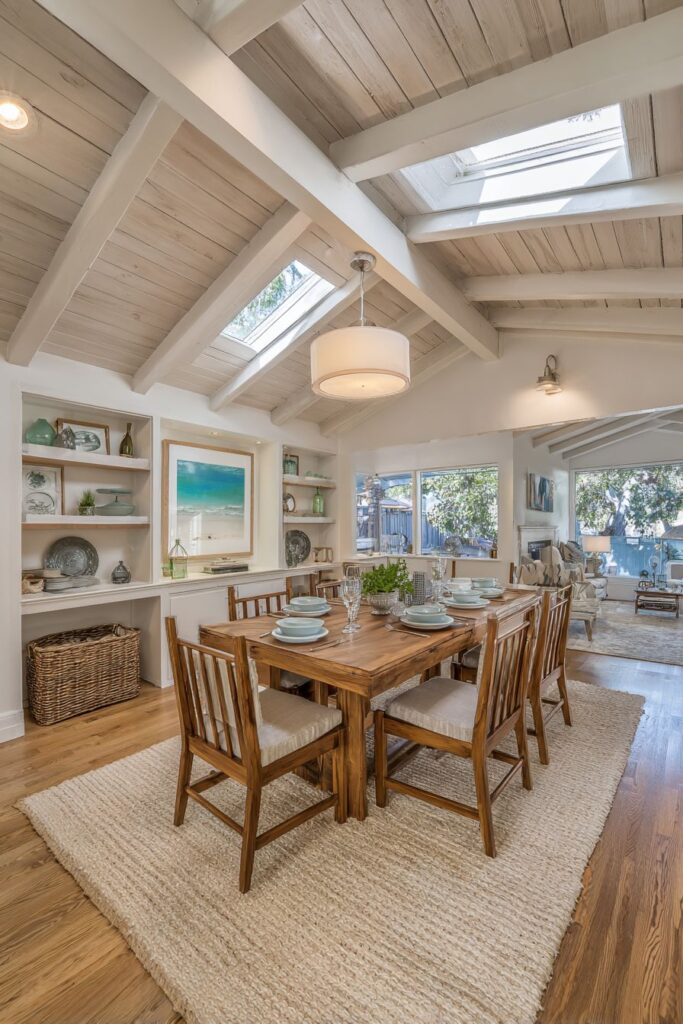
Key Design Tips:
- Use vertical wood treatments to add height and architectural interest
- Vary plank widths and stain tones for dynamic visual composition
- Choose round pedestal tables for intimate dining and clean sight lines
- Display handcrafted objects as functional art throughout the space
- Maintain consistent wood finishes while celebrating natural grain variations
15. Rough-Sawn Douglas Fir Communal Table with Mixed Seating
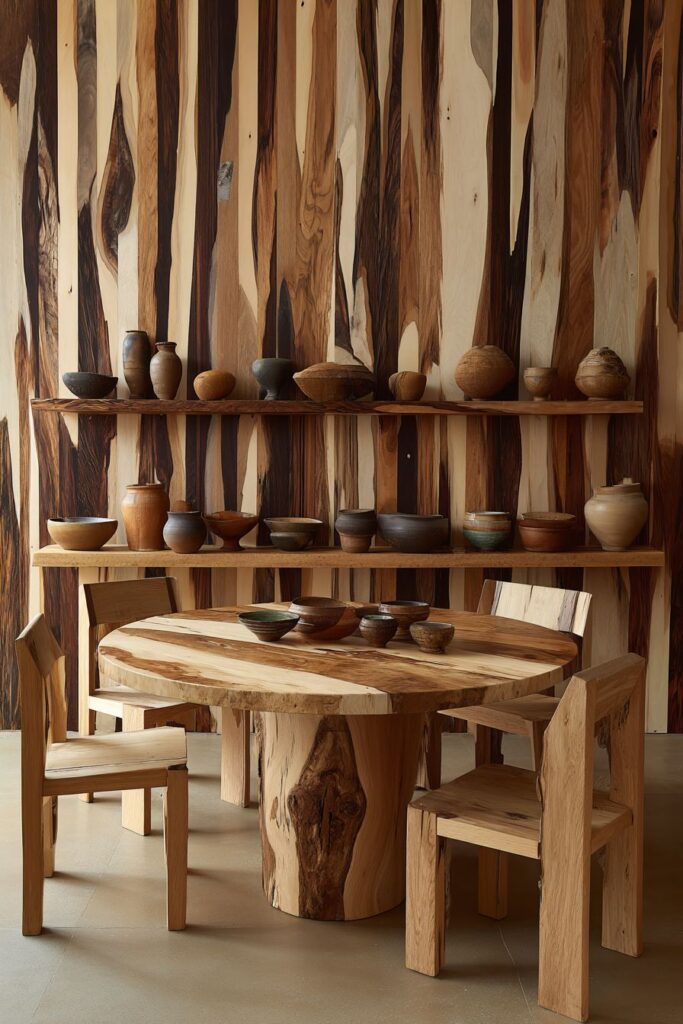
This rustic natural dining room embraces the authentic character of working wood surfaces and traditional construction techniques. The long communal dining table made from rough-sawn douglas fir showcases the honest beauty of lumber in its most natural state. Visible saw marks create subtle texture across the surface, while natural checking and grain patterns tell the story of the tree’s growth and the sawyer’s craft.
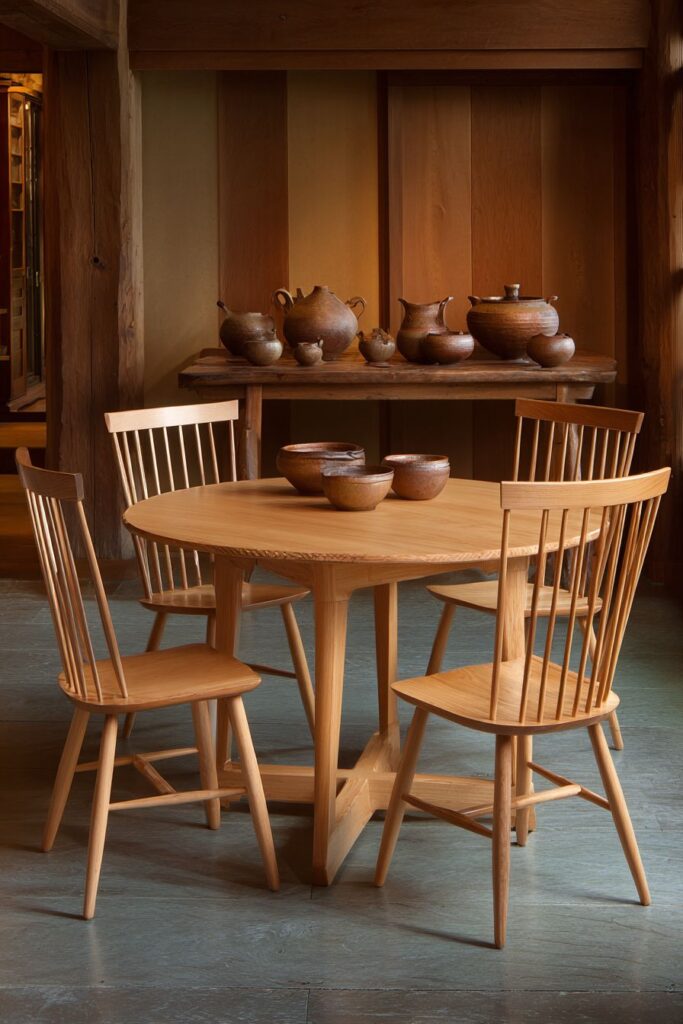
The mix of wooden benches and Windsor chairs creates an eclectic seating arrangement that feels collected over time rather than purchased as a matching set. Each piece shows natural patina developed through years of use, with smooth spots where hands have rested and gentle wear that speaks to countless family meals and gatherings. This authentic aging cannot be replicated artificially and adds immeasurable character to the space.
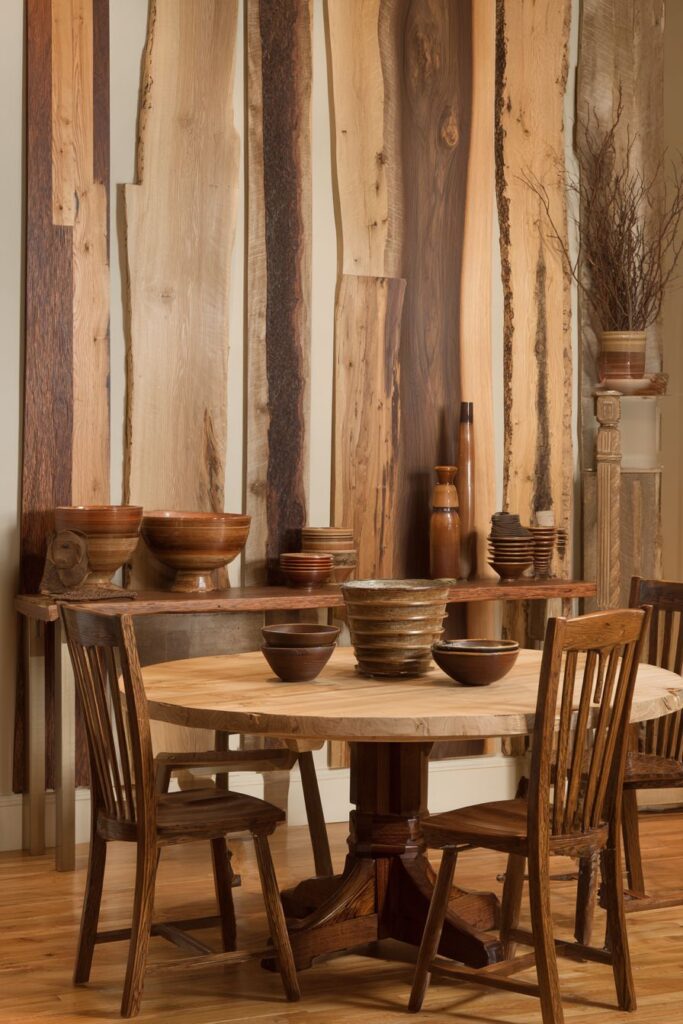
Exposed stone foundation walls provide dramatic textural backdrop that reinforces the connection to traditional building techniques and natural materials. The stone’s irregular surface and varied coloring create depth and visual interest while providing excellent thermal mass that helps moderate indoor temperatures naturally. The exposed foundation becomes architectural art that celebrates honest construction methods.
A collection of vintage wooden cutting boards displayed as wall art demonstrates how functional objects can become decorative elements when thoughtfully arranged. These well-used boards show the beautiful patina and knife marks that develop over decades of kitchen use, turning everyday tools into objects of beauty that tell stories of countless meal preparations.
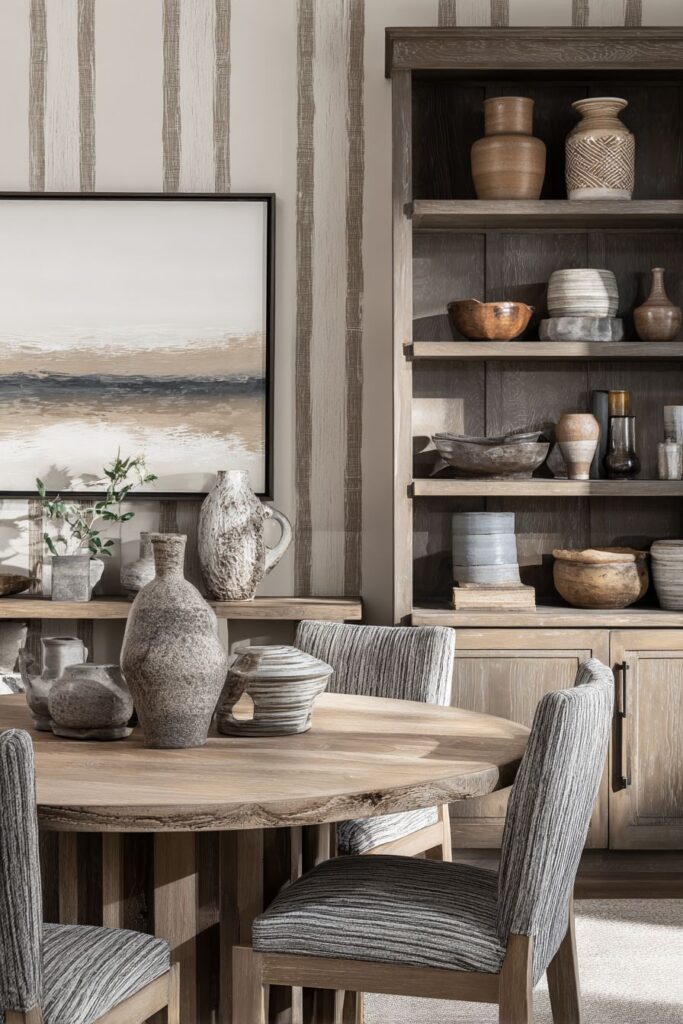
Key Design Tips:
- Embrace rough-sawn lumber for authentic texture and character
- Mix vintage seating pieces for collected-over-time authenticity
- Display functional objects like cutting boards as wall art
- Expose foundation walls to celebrate structural honesty
- Look for furniture pieces that show natural wear and patina development
16. French Doors with Garden Connection and Bleached Oak Table
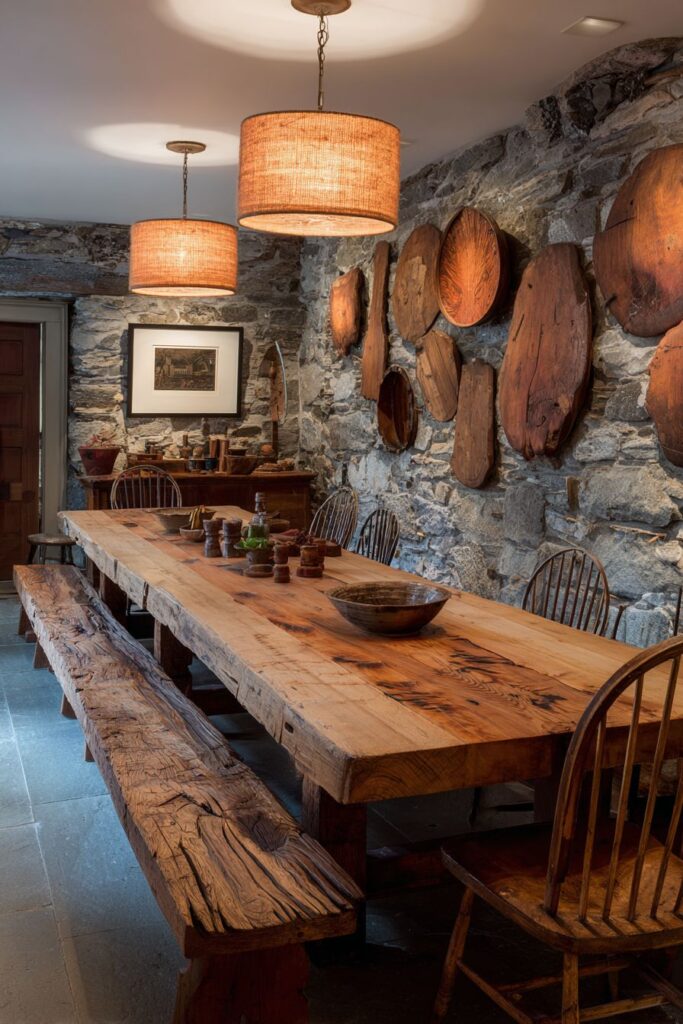
This enchanting natural dining room demonstrates the powerful impact of connecting interior spaces directly with outdoor gardens through thoughtful architectural design. French doors opening to a garden create seamless indoor-outdoor flow while the natural linen curtain panels flutter gently in the breeze, adding movement and life to the space. The curtain panels provide privacy and light control when needed while maintaining the airy, open feeling that makes the space so inviting.
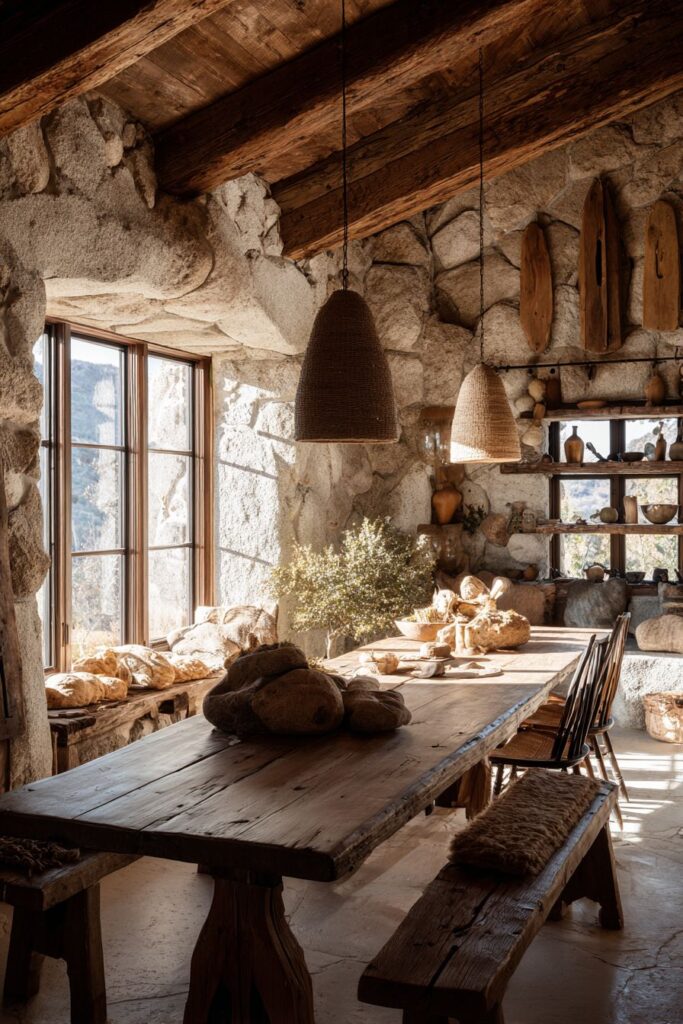
The parsons-style dining table in bleached oak showcases how lighter wood finishes can create sophisticated natural interiors without relying solely on dark, rustic tones. The bleaching process highlights the oak’s distinctive grain patterns while creating a softer, more contemporary appearance that works beautifully with the garden connection. The clean parsons design provides modern simplicity that doesn’t compete with the natural materials and outdoor views.
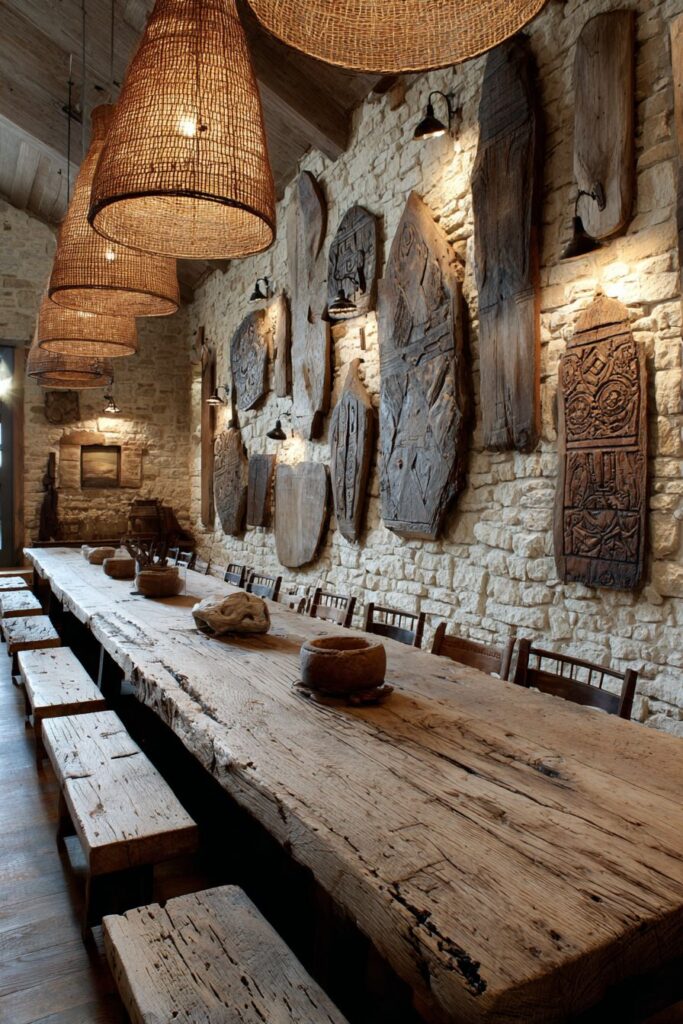
Upholstered dining chairs in organic cotton fabric provide comfort while maintaining the natural fiber commitment throughout the space. Organic cotton offers breathability and comfort while supporting sustainable farming practices, making it an excellent choice for environmentally conscious interiors. The neutral upholstery allows the beautiful wood and garden views to remain the visual focus.
Terra cotta pots with herbs line the windowsills, creating a practical herb garden that serves both decorative and culinary purposes. The terra cotta material adds earthy color while the fresh herbs provide wonderful aromas and connection to seasonal growing cycles. A vintage wooden ladder serves as a creative plant stand, adding vertical interest while providing display space for additional plants or decorative objects.
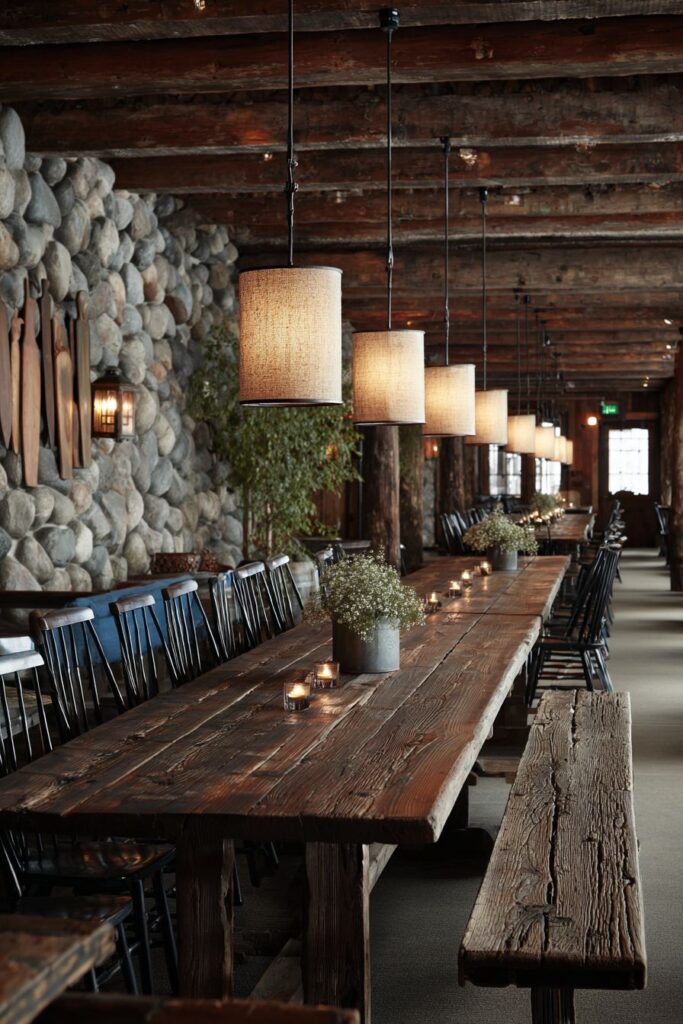
Key Design Tips:
- Install French doors to blur boundaries between indoor and outdoor spaces
- Use lighter wood finishes for contemporary natural appeal
- Choose organic fabrics for environmental responsibility and comfort
- Create windowsill herb gardens for fresh ingredients and natural fragrance
- Repurpose vintage items like ladders for creative plant displays
17. Dramatic Reclaimed Wood Ceiling with Waterfall Edge Table
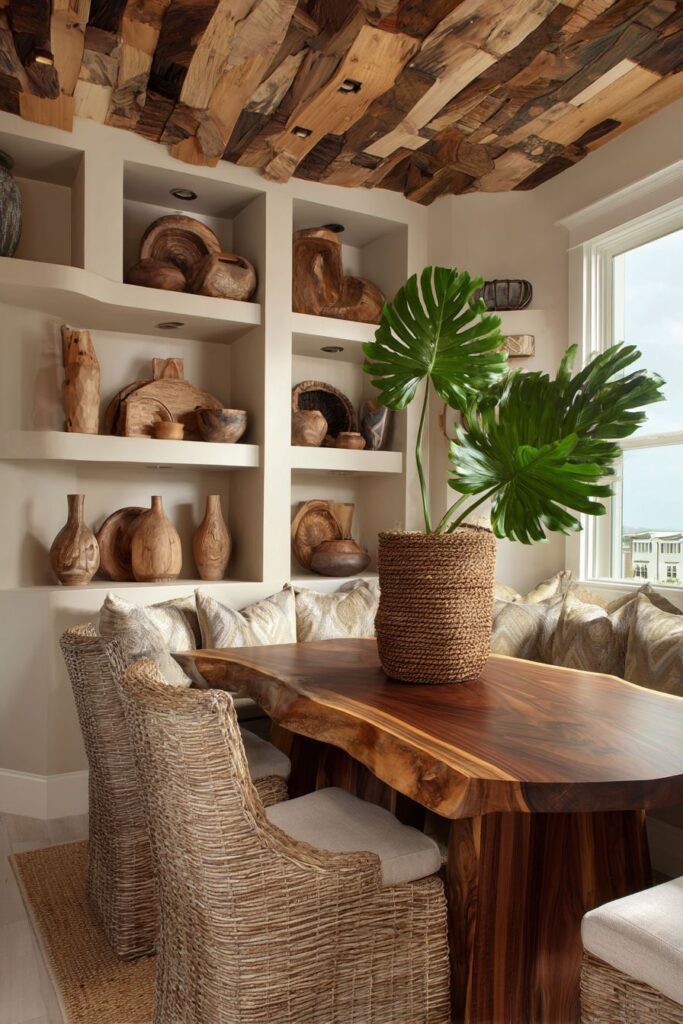
This stunning natural dining room showcases how ceiling treatments can become the room’s most dramatic design element. The ceiling features reclaimed wood planks in varying tones from honey to deep brown, creating a rich tapestry of color and texture overhead. The varied tones result from different ages, wood species, and weathering patterns, creating visual complexity that draws the eye upward while adding warmth and character to the entire space.
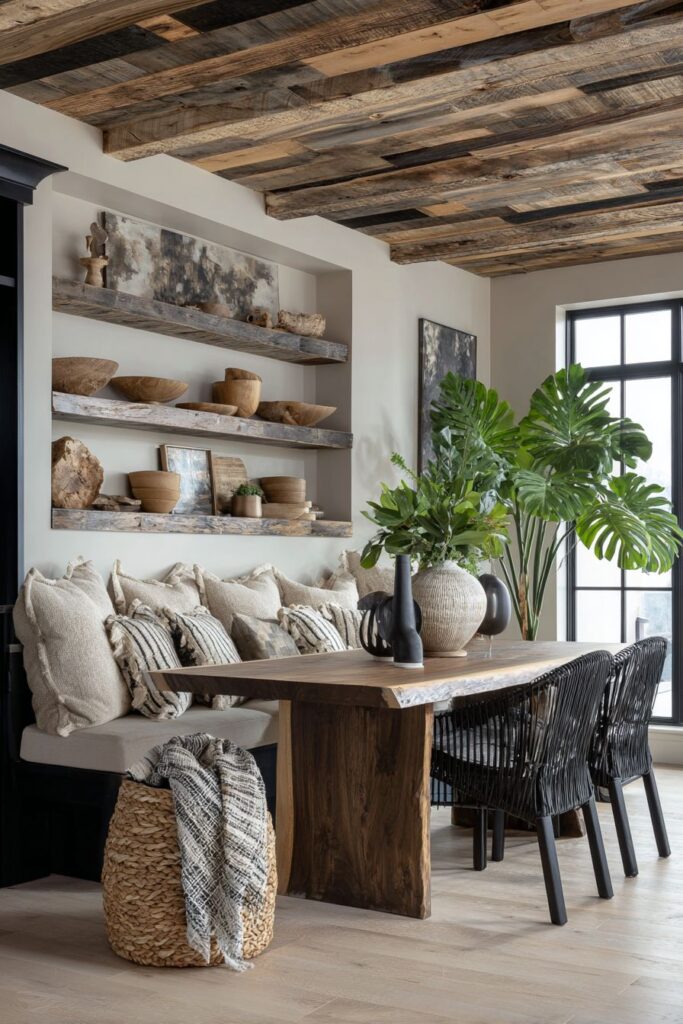
The solid walnut dining table with waterfall edge detail serves as a sculptural centerpiece that demonstrates wood’s incredible beauty and versatility. The waterfall edge extends the wood grain continuously from the table top down the sides, creating visual flow that showcases the walnut’s distinctive patterns. This technique requires exceptional craftsmanship and material selection, resulting in a truly unique piece of functional art.
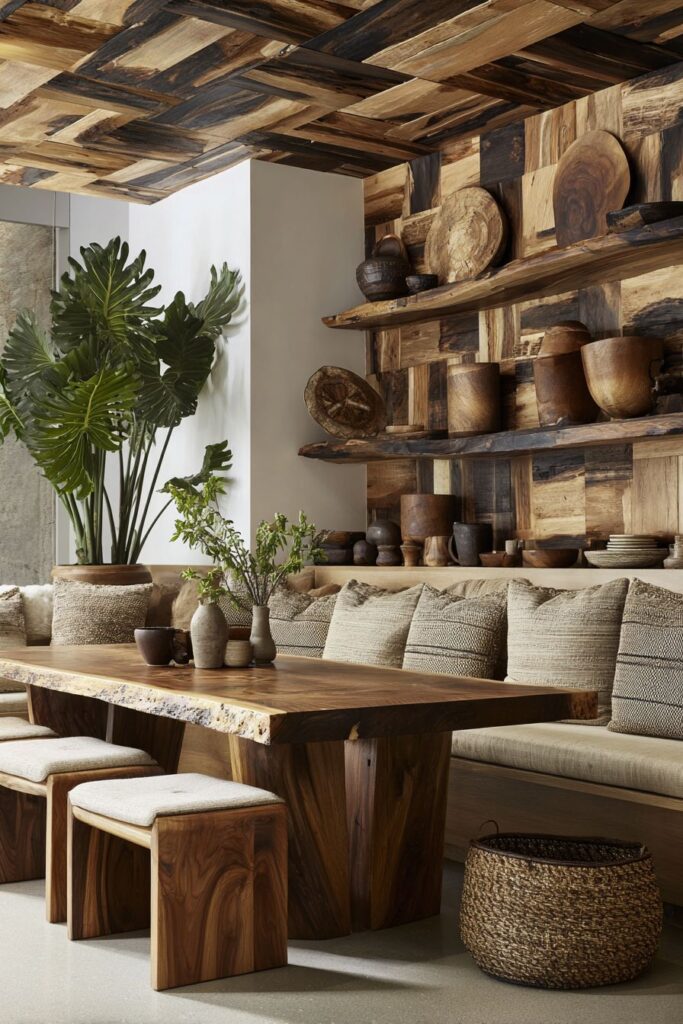
A built-in banquette with natural linen upholstery maximizes seating while creating clean lines that complement the table’s sophisticated design. The banquette’s linear form provides visual balance to the rich ceiling treatment while offering comfortable seating that encourages long conversations. Natural linen upholstery maintains the organic material palette while providing durability and easy maintenance.
A collection of wooden serving pieces displayed on floating shelves continues the celebration of wood’s natural beauty while providing functional storage. Each piece showcases different wood species and grain patterns, creating an educational display of wood’s diversity. A large monstera plant in a woven basket adds organic sculptural form while providing air purification and the psychological benefits of indoor greenery.
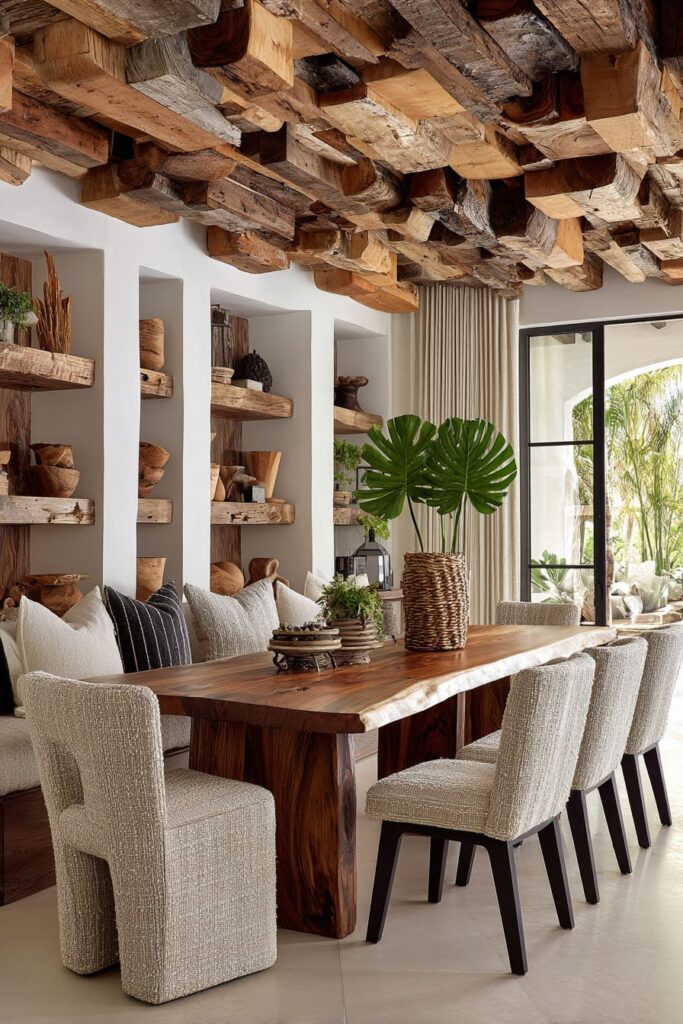
Key Design Tips:
- Create dramatic ceiling treatments using varied reclaimed wood tones
- Choose waterfall edge tables for sophisticated woodworking display
- Use built-in seating to maximize space efficiency and create clean lines
- Display wooden objects to showcase natural material diversity
- Include large plants as living sculpture and air purification
18. Sustainable Bamboo Dining Set with Living Air Plant Wall
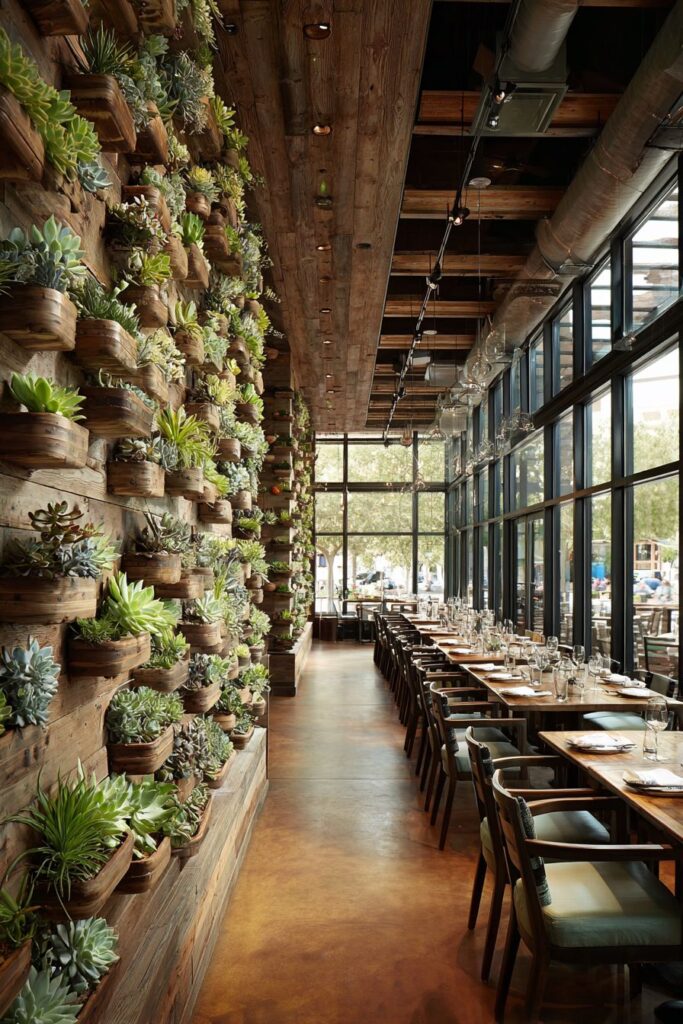
This environmentally conscious natural dining room demonstrates how sustainable materials can create beautiful, functional spaces while supporting environmental responsibility. The dining set made from certified sustainable bamboo showcases this remarkable grass’s strength, beauty, and rapid renewability. The natural finish highlights bamboo’s characteristic nodes and linear grain patterns, creating visual interest while celebrating the material’s unique growth characteristics.

A living wall of air plants mounted on reclaimed wood backing creates a stunning vertical garden that requires no soil or traditional watering systems. Air plants absorb moisture and nutrients from the air, making them perfect for vertical installations while providing air purification benefits. The reclaimed wood backing adds textural interest while supporting the sustainability theme throughout the space.
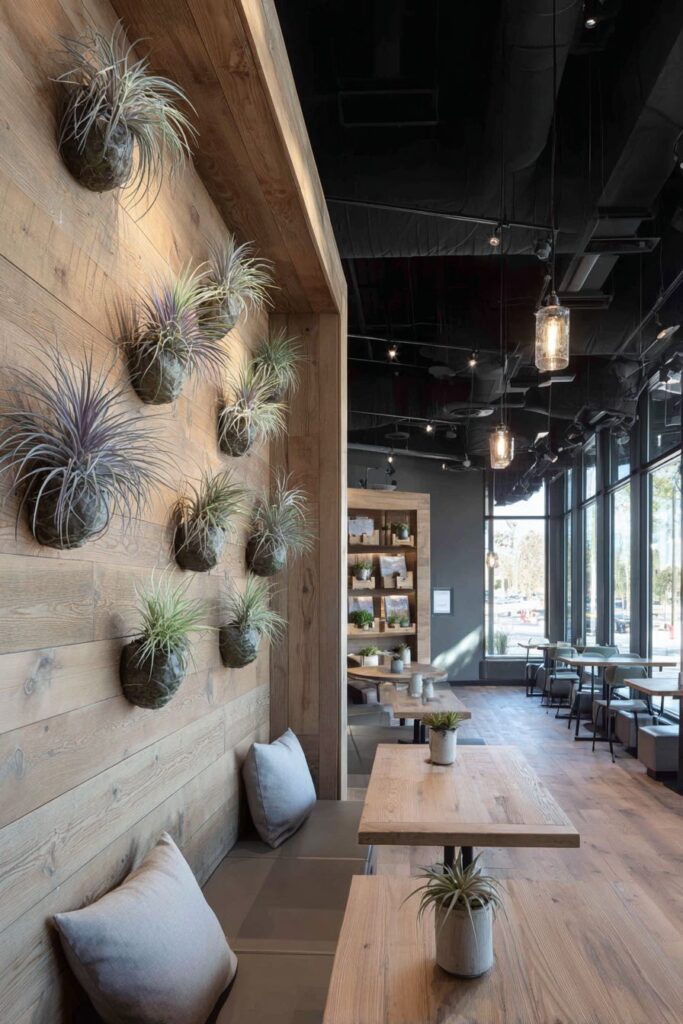
Seating cushions made from organic hemp fabric provide comfort while showcasing another sustainable natural fiber option. Hemp offers exceptional durability and antimicrobial properties while requiring minimal water and pesticides to grow. The natural color and texture of hemp fabric complement the bamboo furniture while reinforcing the environmental consciousness of the design choices.
Cork flooring provides a natural surface that’s warm underfoot while offering excellent acoustic properties and natural antimicrobial qualities. Cork’s unique cellular structure provides natural insulation and cushioning while its harvesting process doesn’t harm the cork oak trees, making it one of the most sustainable flooring options available.
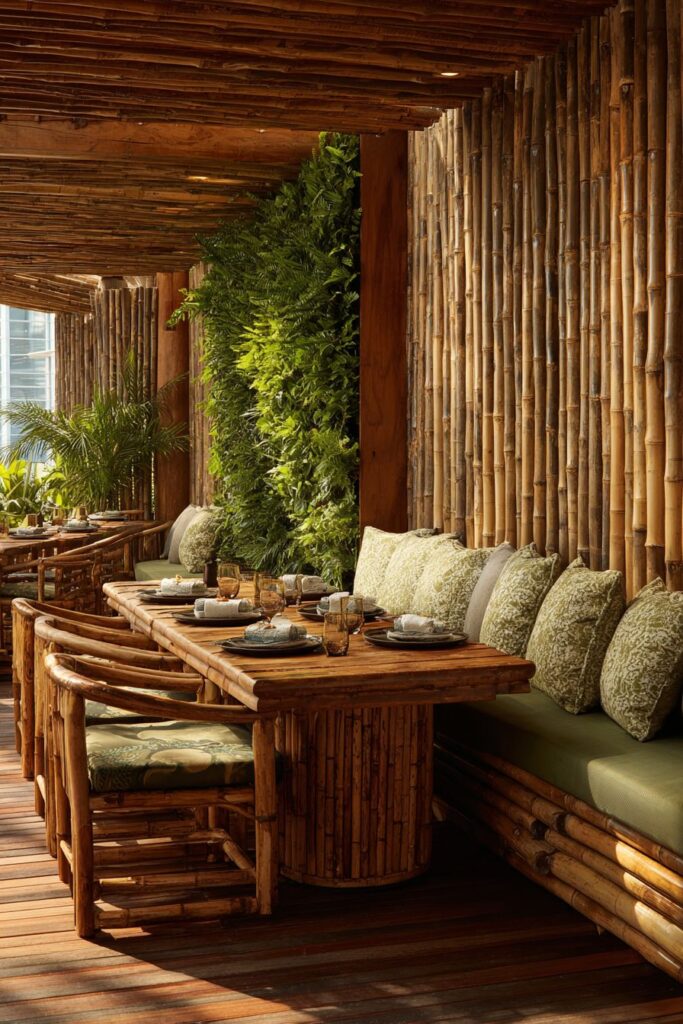
Key Design Tips:
- Choose certified sustainable materials to support environmental responsibility
- Create living walls with low-maintenance plants like air plants
- Use hemp fabrics for durability and antimicrobial properties
- Install cork flooring for warmth, comfort, and acoustic benefits
- Mount air plant displays on reclaimed materials for added sustainability
19. Zinc-Topped Table with Industrial-Natural Material Mix
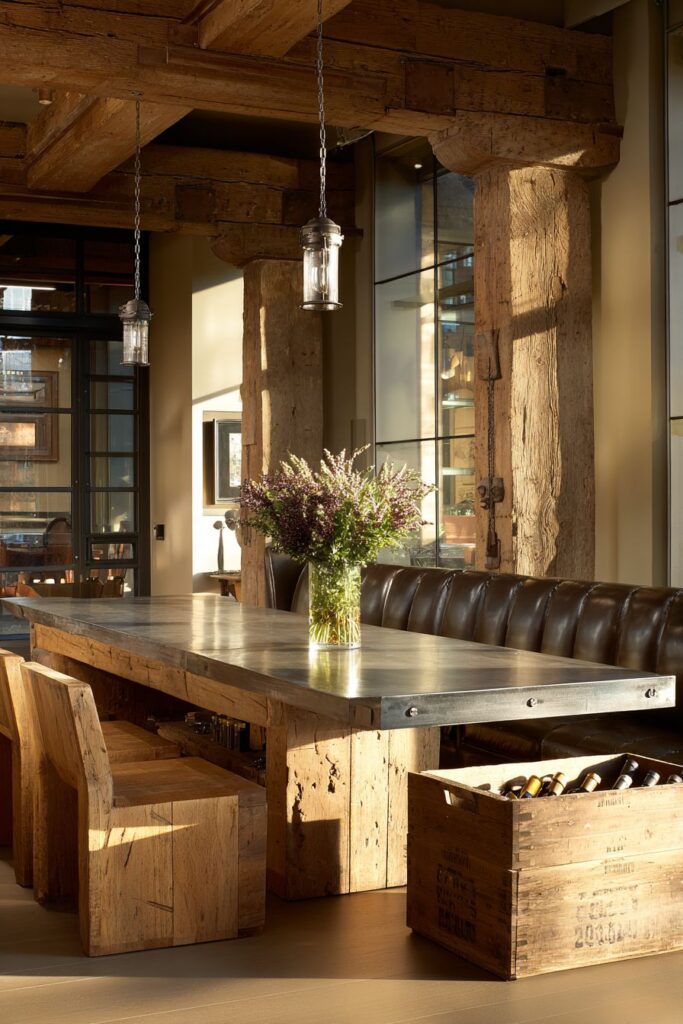
This sophisticated natural dining room demonstrates how industrial elements can complement organic materials for contemporary appeal. The zinc-topped dining table showcases the metal’s natural patina and weathering effects, which develop beautiful character over time. Zinc’s natural oxidation creates subtle color variations and texture that add visual interest while requiring no artificial finishing or maintenance.
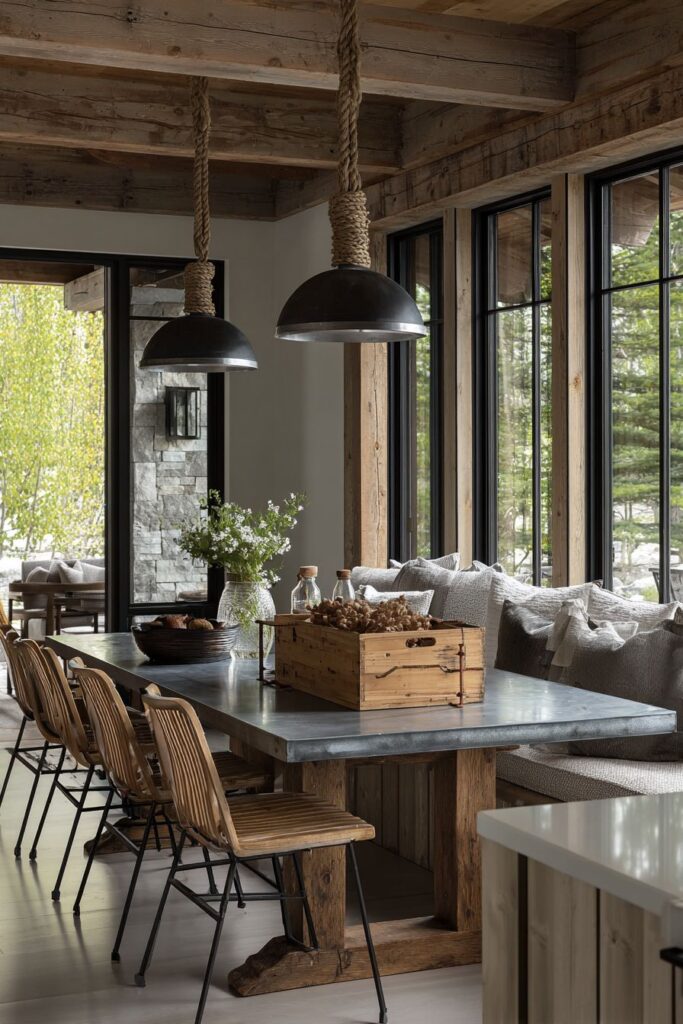
The table base made from reclaimed barn beams with visible mortise and tenon joinery celebrates traditional woodworking techniques while providing massive visual weight that anchors the space. The mortise and tenon joints represent centuries of woodworking tradition, creating incredibly strong connections without metal fasteners. These joinery details become decorative elements that showcase the craftsman’s skill and attention to detail.
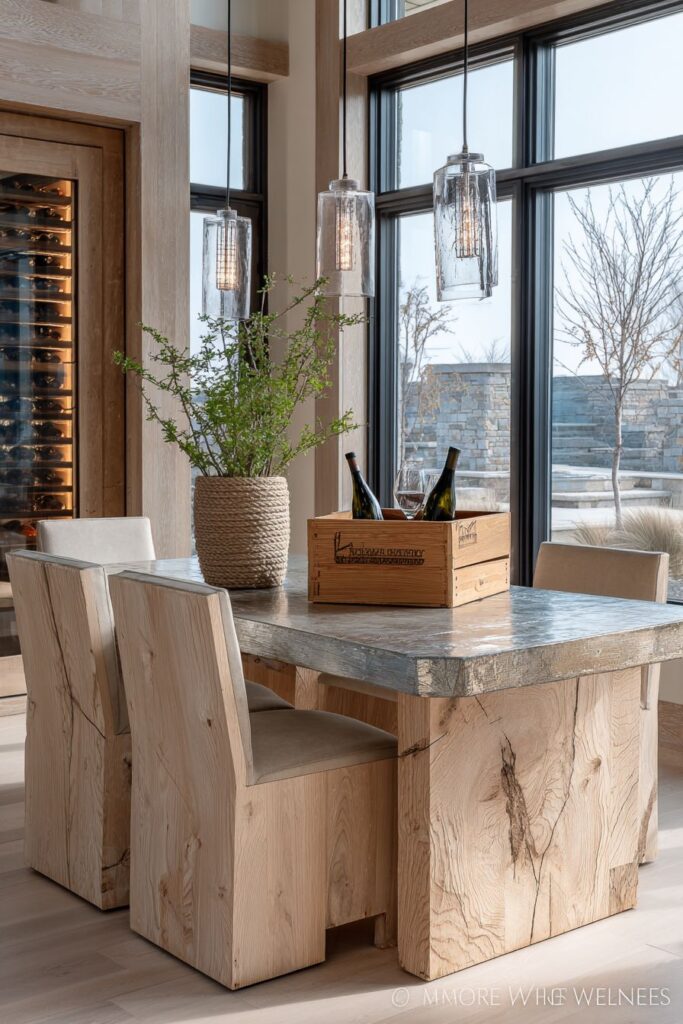
Industrial-style pendant lights with natural rope cord covers provide task lighting while maintaining the mixed material aesthetic. The rope covers soften the industrial fixtures while adding organic texture that connects with the natural materials elsewhere in the space. This detail shows how small touches can successfully blend different design elements into cohesive compositions.
Dining chairs made from bent plywood show the wood grain layers created during the molding process, adding visual interest while demonstrating wood’s versatility and strength. The bent plywood construction creates ergonomic curves that provide comfort while the visible grain layers create subtle pattern and texture. A vintage wooden wine crate serves as a unique centerpiece holder, adding rustic charm while providing practical functionality.
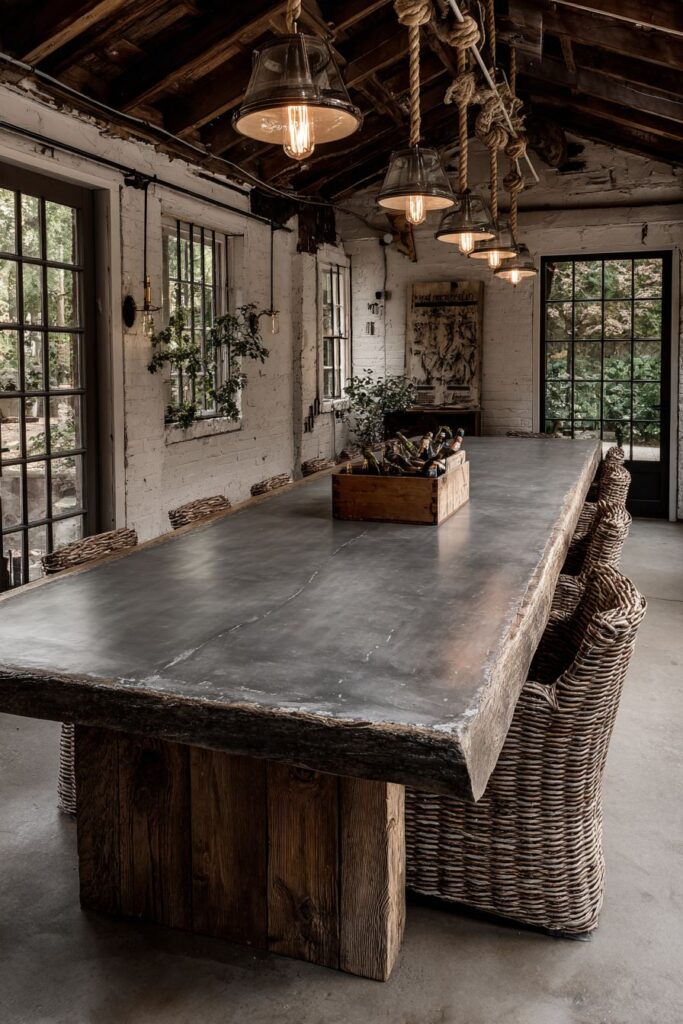
Key Design Tips:
- Mix industrial materials like zinc with natural wood for contemporary appeal
- Showcase traditional joinery techniques as decorative elements
- Use rope cord covers to soften industrial lighting fixtures
- Choose bent plywood to highlight wood’s versatility and strength
- Repurpose vintage containers as unique functional accessories
20. Open Concept Flow with Live-Edge Black Walnut Island Counter
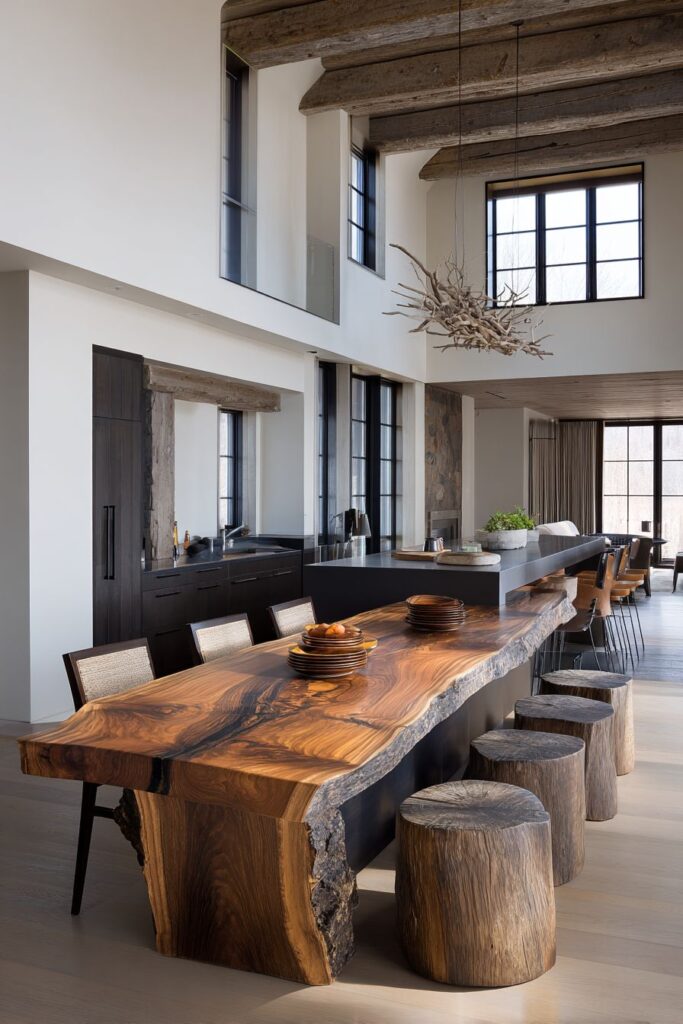
This innovative natural dining room demonstrates how open concept layouts can successfully integrate dining and kitchen functions while maintaining distinct zones through thoughtful material choices. The kitchen island extending into a dining counter made from live-edge black walnut creates a stunning focal point that serves multiple functions while showcasing one of North America’s most prized hardwoods. The black walnut’s rich chocolate tones and distinctive grain patterns create natural artwork across the counter surface.
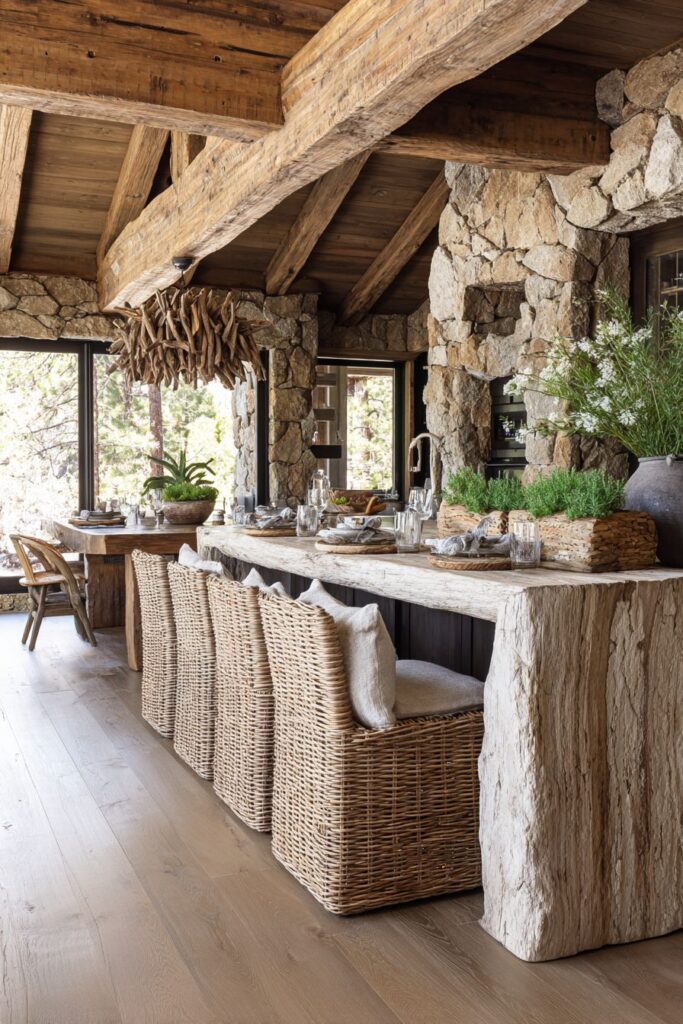
The live edge with natural bark inclusion preserves the tree’s original form while adding incredible character and authenticity to the functional surface. Black walnut’s dense grain and natural oils make it exceptionally durable for food preparation while developing even richer patina over time. The bark inclusion adds textural interest and ensures each counter is absolutely unique.
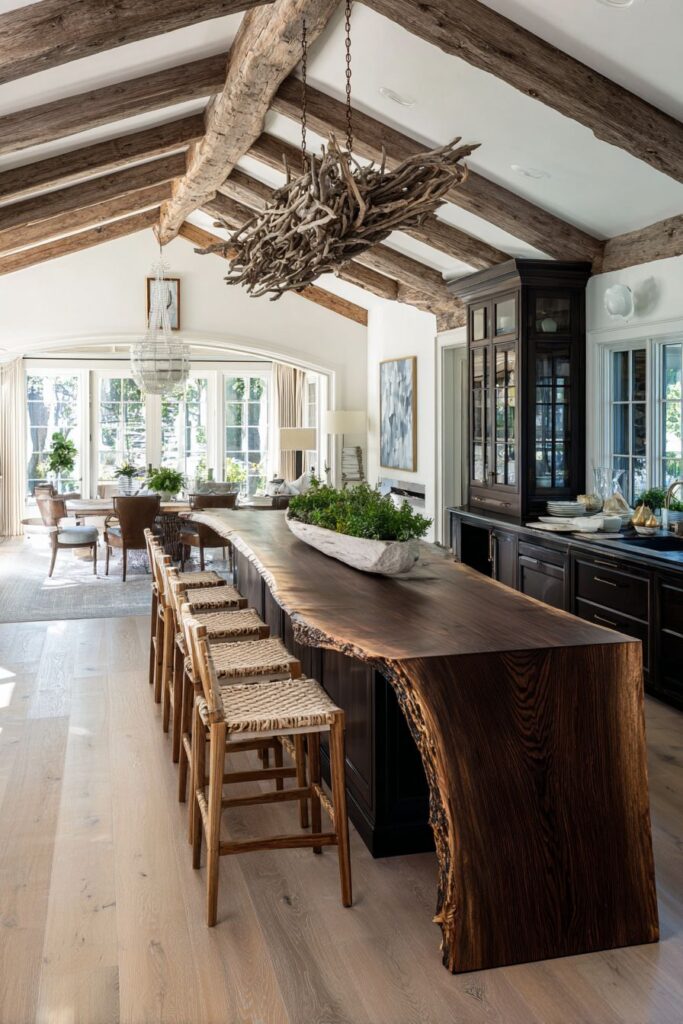
Counter-height stools with woven seats provide comfortable dining while maintaining sight lines across the connected spaces. The woven seats add organic texture while the counter height creates casual dining that encourages interaction with kitchen activities. This arrangement makes meal preparation a social activity rather than isolated kitchen work.
A statement light fixture made from driftwood provides artistic focal point while reinforcing the connection to natural materials throughout the integrated spaces. The driftwood’s sculptural form, shaped by natural forces, becomes functional art that provides ambient lighting. A herb garden in reclaimed wood planters brings fresh ingredients within easy reach while adding living elements to the functional spaces.
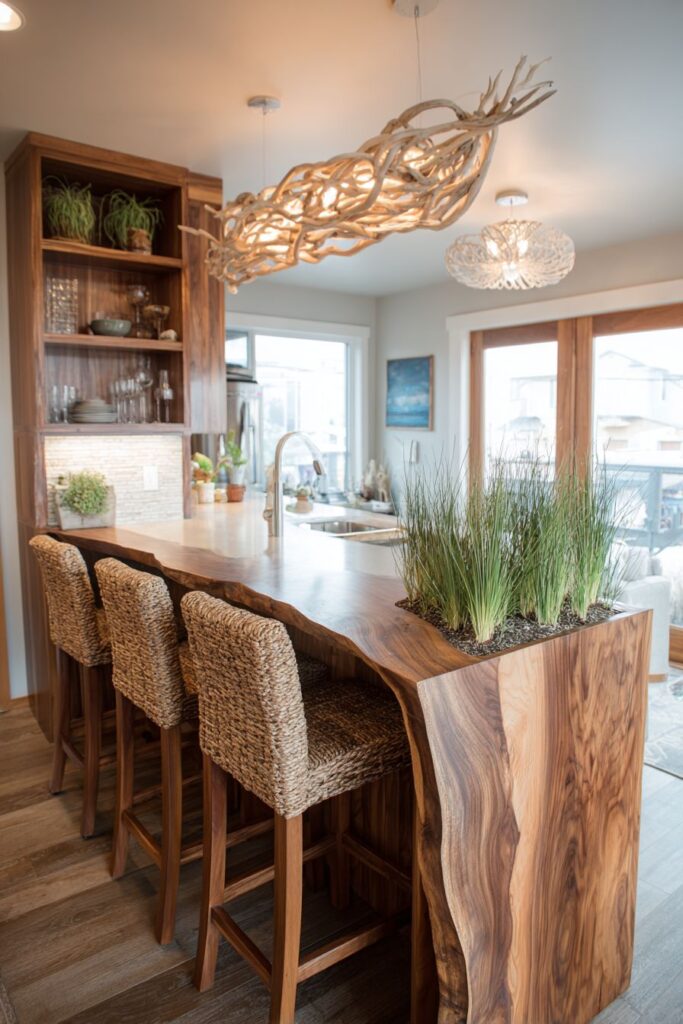
Key Design Tips:
- Use live-edge counters to create stunning focal points in open layouts
- Choose premium hardwoods like black walnut for durability and beauty
- Maintain sight lines with counter-height seating in open concepts
- Include herb gardens near food preparation areas for fresh ingredients
- Use sculptural lighting to define zones within open floor plans
Why These Natural Dining Room Designs Represent the Best in Organic Interior Design
These twenty natural dining room concepts represent the pinnacle of organic interior design because they successfully combine aesthetic beauty with functional practicality while honoring sustainable design principles. Each design celebrates the inherent beauty found in natural materials like reclaimed wood, natural stone, organic fibers, and living plants, creating spaces that feel both sophisticated and grounded in nature’s timeless appeal.
The emphasis on authentic materials and traditional craftsmanship techniques creates dining rooms with genuine character that improves with age rather than deteriorating over time. Live-edge tables, hand-woven textiles, exposed ceiling beams, and natural stone elements bring honest beauty that cannot be replicated with manufactured alternatives. These materials develop patina and character through use, making each space more beautiful and meaningful over time.
Sustainability considerations run throughout these designs, from certified sustainable bamboo furniture to reclaimed barn wood tables that give new life to materials that might otherwise become waste. Cork flooring, organic cotton upholstery, and hemp fabrics demonstrate how environmentally responsible choices can enhance rather than compromise design beauty. Air plants and herb gardens provide natural air purification while connecting interior spaces with growing cycles and seasonal changes.
The integration of indoor and outdoor spaces through floor-to-ceiling windows, French doors, and garden views creates dining rooms that feel connected to natural landscapes while maintaining interior comfort and functionality. Natural light becomes a design element that highlights wood grain patterns, creates dynamic shadows, and changes throughout the day to keep spaces feeling alive and dynamic.
These natural dining room designs prove that organic materials and sustainable practices can create incredibly sophisticated, beautiful spaces that support both human wellbeing and environmental responsibility. They represent the best in contemporary interior design by honoring traditional craftsmanship while meeting modern lifestyle needs.
Conclusion
Natural dining rooms represent more than just interior design trends—they embody a philosophy of living that values authenticity, sustainability, and connection to the earth’s natural beauty. The twenty design concepts explored in this comprehensive guide demonstrate the incredible versatility and timeless appeal of organic materials, traditional craftsmanship, and biophilic design principles.
From the dramatic beauty of live-edge walnut tables to the sustainable elegance of bamboo dining sets, these spaces prove that environmentally conscious choices enhance rather than limit design possibilities. The integration of reclaimed materials, traditional joinery techniques, and living plants creates dining rooms that tell stories, develop character over time, and provide meaningful connections to both natural world and human heritage.
Whether you’re drawn to the rustic charm of exposed stone walls, the sophisticated simplicity of bleached oak furnishings, or the innovative beauty of air plant living walls, these natural dining room designs offer inspiration for creating spaces that nourish both body and soul. The key lies in choosing authentic materials, celebrating traditional craftsmanship, and maintaining strong connections to natural light, outdoor views, and seasonal changes.
As we continue to recognize the importance of sustainable living and biophilic design for human wellbeing, natural dining rooms will undoubtedly remain at the forefront of interior design innovation. These spaces remind us that the most beautiful interiors are those that honor both our need for functional comfort and our deep, instinctive connection to the natural world.
